Kohler CH20, CH18-750, CH750, CH740, CH23 Manual
...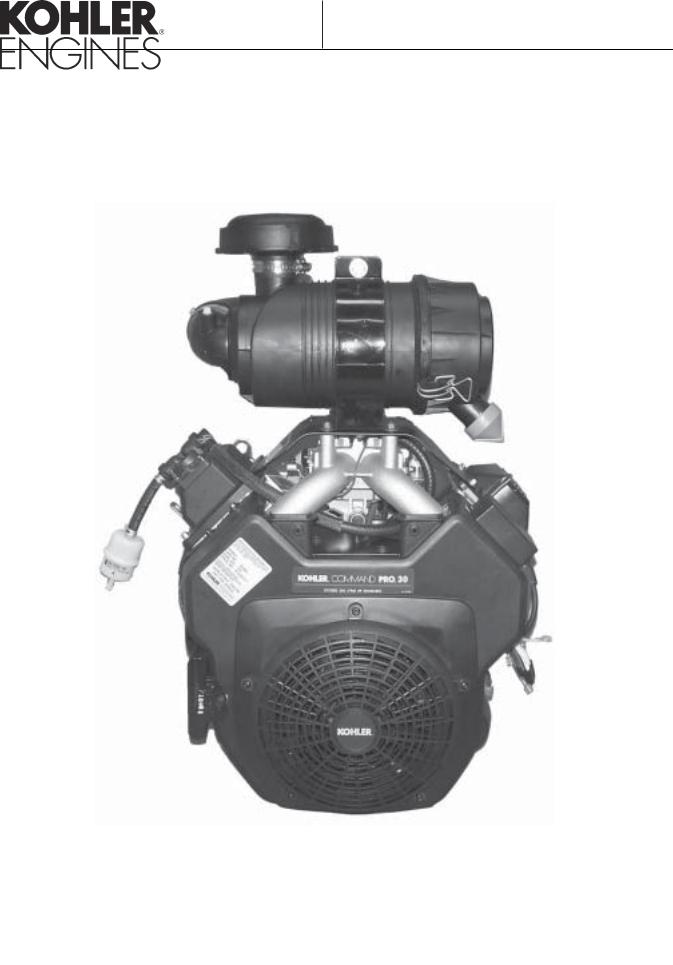
SERVICE MANUAL
 COMMAND CH18-750
COMMAND CH18-750
HORIZONTAL CRANKSHAFT
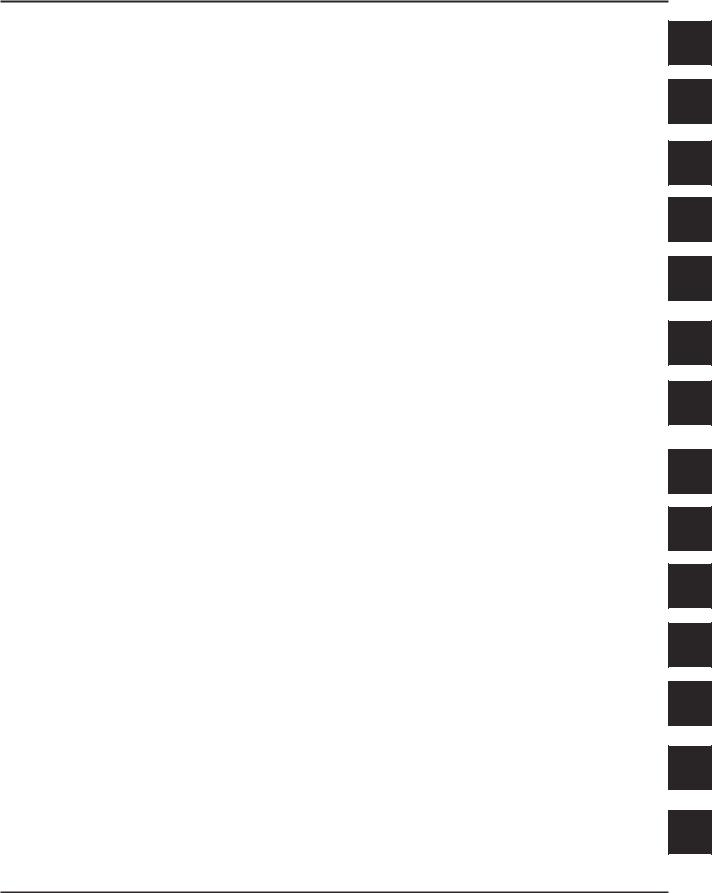
Contents
Section 1. Safety and General Information ............................................................................
Section 2. Special Tools ..........................................................................................................
Section 3. Troubleshooting .....................................................................................................
Section 4. Air Cleaner and Air Intake System ........................................................................
Section 5. Fuel System and Governor ....................................................................................
Section 5A. LPG Fuel Systems ...............................................................................................
Section 5B. Electronic Fuel Injection (EFI) Fuel System ......................................................
Section 6. Lubrication System ................................................................................................
Section 7. Retractable Starter .................................................................................................
Section 8. Electrical System and Components .....................................................................
Section 9. Disassembly ...........................................................................................................
Section 10. Inspection and Reconditioning ...........................................................................
Section 11. Reassembly ...........................................................................................................
Section 12. Clutch ....................................................................................................................
1
2
3
4
5
5A
5B
6
7
8
9
10
11
12

Section 1
Safety and General Information
1
Section 1
Safety and General Information
Safety Precautions
To ensure safe operation please read the following statements and understand their meaning. Also refer to your equipment manufacturer's manual for other important safety information. This manual contains safety precautions which are explained below. Please read carefully.
WARNING
Warning is used to indicate the presence of a hazard that can cause severe personal injury, death, or substantial property damage if the warning is ignored.
CAUTION
Caution is used to indicate the presence of a hazard that will or can cause minor personal injury or property damage if the caution is ignored.
NOTE
Note is used to notify people of installation, operation, or maintenance information that is important but not hazard-related.
For Your Safety!
These precautions should be followed at all times. Failure to follow these precautions could result in injury to yourself and others.
 WARNING
WARNING
Accidental Starts can cause severe injury or death.
Disconnect and ground spark plug leads before servicing.
Accidental Starts!
Disabling engine. Accidental starting can cause severe injury or death.
Before working on the engine or equipment, disable the engine as follows: 1) Disconnect the spark plug lead(s). 2) Disconnect negative (-) battery cable frombattery.
 WARNING
WARNING
Rotating Parts can cause severe injury.
Stay away while engine is in operation.
Rotating Parts!
Keep hands, feet, hair, and clothing away from all moving parts to prevent injury. Never operate the engine with covers, shrouds,orguardsremoved.
 WARNING
WARNING
Hot Parts can cause severe burns.
Do not touch engine while operating or just after stopping.
Hot Parts!
Engine components can get extremely hot from operation. To prevent severe burns, do not touch these areas while the engineisrunning-orimmediatelyafterit is turned off. Never operate the engine with heat shields or guards removed.
1.1
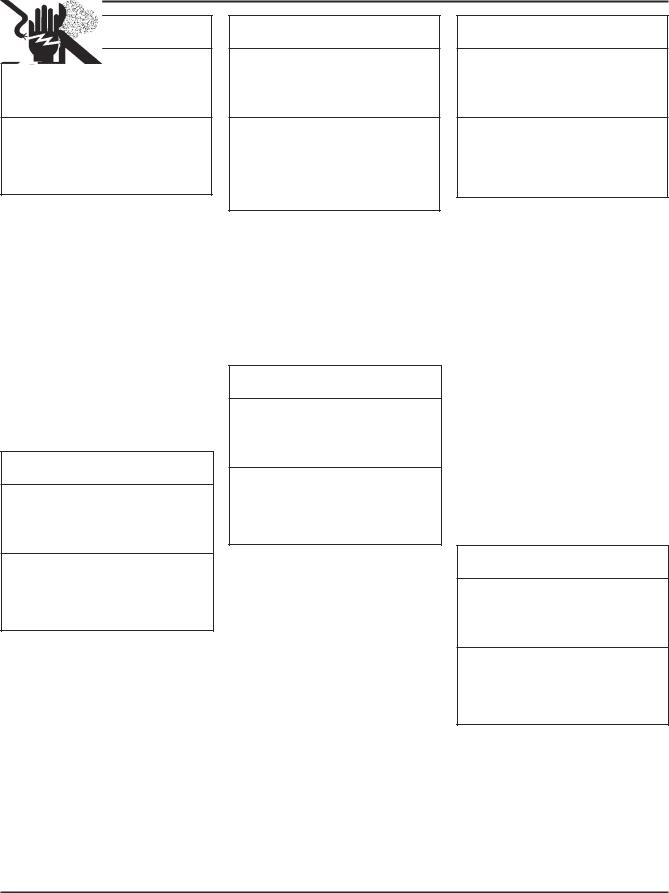
Section 1
Safety and General Information
 WARNING
WARNING
Explosive Fuel can cause fires and severe burns.
Do not fill the fuel tank while the engine is hot or running.
Explosive Fuel!
Gasoline is extremely flammable and its vapors can explode if ignited. Store gasoline only in approved containers, in well ventilated, unoccupied buildings, away from sparks or flames. Do not fill the fuel tank while the engine is hot or running, since spilled fuel could ignite if it comes in contact with hot parts or sparks from ignition. Do not start the engine near spilled fuel. Never use gasoline as a cleaning agent.
 WARNING
WARNING
Cleaning Solvents can cause severe injury or death.
Use only in well ventilated areas away from ignition sources.
Flammable Solvents!
Carburetor cleaners and solvents are extremely flammable. Keep sparks, flames, and other sources of ignition away from the area. Follow the cleaner manufacturer’swarningsand instructionsonitsproperandsafeuse. Never use gasoline as a cleaning agent.
 WARNING
WARNING
Carbon Monoxide can cause severe nausea, fainting or death.
Avoid inhaling exhaust fumes, and never run the engine in a closed building or confined area.
Lethal Exhaust Gases!
Engine exhaust gases contain poisonous carbonmonoxide.Carbonmonoxideis odorless, colorless, and can cause death if inhaled. Avoid inhaling exhaust fumes, and never run the engine in a closed building or confined area.
 WARNING
WARNING
Uncoiling Spring can cause severe injury.
Wear safety goggles or face protection when servicing retractable starter.
Spring Under Tension!
Retractable starters contain a powerful, recoilspringthatisundertension. Always wear safety goggles when servicingretractablestartersand carefully follow instructions in the "Retractable Starter" Section 7 for relievingspringtension.
 WARNING
WARNING
Explosive Gas can cause fires and severe acid burns.
Charge battery only in a well ventilated area. Keep sources of ignition away.
Explosive Gas!
Batteries produce explosive hydrogen gas while being charged. To prevent a fire or explosion, charge batteries only in well ventilated areas. Keep sparks, open flames, and other sources of ignition away from the battery at all times. Keep batteries out of the reach of children. Remove all jewelry when servicing batteries.
Before disconnecting the negative (-) ground cable, make sure all switches are OFF. If ON, a spark will occur at the ground cable terminal which could cause an explosion if hydrogen gas or gasoline vaporsarepresent.
 CAUTION
CAUTION
Electrical Shock can cause injury.
Do not touch wires while engine is running.
Electrical Shock!
Never touch electrical wires or components while the engine is running. They can be sources of electrical shock.
1.2
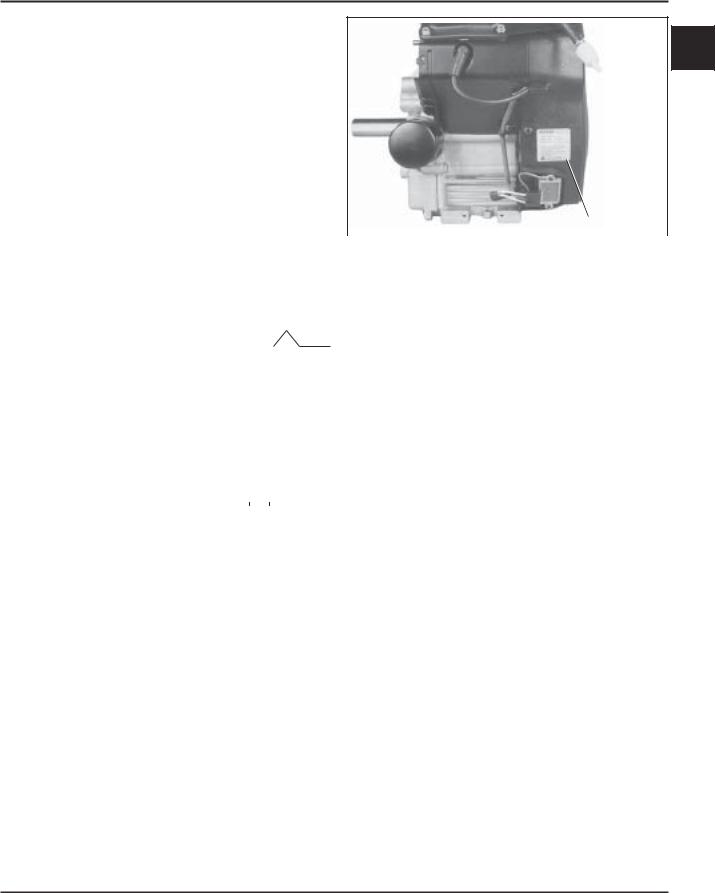
Section 1
Safety and General Information
Engine Identification Numbers
When ordering parts, or in any communication
involving an engine, always give the Model, 1
Specification and Serial Numbers, including letter suffixes if there are any.
The engine identification numbers appear on a decal, or decals, affixed to the engine shrouding. See Figure 1-1. An explanation of these numbers is shown in Figure 1-2.
|
|
|
|
|
|
|
|
|
|
|
|
|
|
|
|
|
|
|
|
|
|
|
|
|
|
|
|
|
|
|
|
|
|
|
|
|
|
|
|
|
|
|
|
|
|
|
|
Identification Decal |
|
|
|
|
|
|
|
|
|
|
|
|
|
|
|
|
|
|
|
|
|
|
|
|
|
|
|
|
|
|
|
|
Figure 1-1. Engine Identification Decal Location. |
||||||||||||||||
|
|
|
|
|
|
|
|
|
|
|
|
|
|
|
|
|
|
|
|
|
|
|
|
|
|
|
|
|
|
|
|
|
|
|
|
|
|
|
|
|
|
|
|
|
|
|
|
|
A. Model No. |
|
|
|
|
|
|
|
|
C H 18 S |
|
|
|
|
|
|
|
|
|
|
|
|
|
|
|
|
|
|
|
|
|
|
|
|
|
||||||||||||||
|
Command Engine |
|
|
|
|
|
|
|
|
|
|
|
|
|
|
|
|
|
|
|
|
|
|
|
|
|
|
|
|
|
|
|
|
|
|
|
|
|
|
|
|
Version Code |
||||||
|
|
|
|
|
|
|
|
|
|
|
|
|
|
|
|
|
|
|
|
|
|
|
|
|
|
|
|
|
|
|
|
|
|
|
|
|
|
|
|
|||||||||
|
Horizontal Crankshaft |
|
|
|
|
|
|
|
|
|
|
|
|
|
|
|
|
|
|
|
|
|
|
|
|
|
|
|
|
|
|
|
|
|
|
|
|
|
|
|
||||||||
|
|
|
|
|
|
|
|
|
|
|
|
|
|
|
|
|
|
|
|
|
|
|
|
|
|
|
|
|
|
|
|
|
|
|
|
|
|
|
|
S = Electric Start |
||||||||
|
|
|
|
|
|
|
|
|
|
|
|
|
|
|
|
|
|
|
|
|
|
|
|
|
|
|
|
|
|
|
|
|
|
|
|
|
|
|||||||||||
|
|
Horsepower |
|
|
|
|
|
|
|
|
|
|
|
|
|
|
or |
|
|
|
|
|
|
Numerical Designation |
||||||||||||||||||||||||
|
|
|
|
|
|
|
|
|
|
|
|
|
|
|
|
|
|
|
||||||||||||||||||||||||||||||
|
|
17 = 17 HP |
|
|
|
|
|
|
|
|
|
|
|
|
|
|
|
|
|
|
730 |
|
|
|
|
|
|
|
|
|
|
|
||||||||||||||||
|
|
18 = 18 HP |
|
|
|
|
|
|
|
|
|
|
|
|
|
|
|
|
|
|
740 |
|
|
|
|
|
|
|
|
|
|
|
||||||||||||||||
|
|
20 = 20 HP |
|
|
|
|
|
|
|
|
|
|
|
|
|
|
|
|
|
|
745 |
|
|
|
|
|
|
|
|
|
|
|
||||||||||||||||
|
|
22 = 22 HP |
|
|
|
|
|
|
|
|
|
|
|
|
|
|
|
|
|
|
750 |
|
|
|
|
|
|
|
|
|
|
|
||||||||||||||||
|
|
23 = 23 HP |
|
|
|
|
|
|
|
|
|
|
|
|
|
|
|
|
|
|
|
|
|
|
|
|
|
|
|
|
|
|
|
|
|
|
|
|
|
|
|
|
|
|
|
|||
|
|
25 = 25 HP |
|
|
|
|
|
|
|
|
|
|
|
|
|
|
|
|
|
|
|
|
|
|
|
|
|
|
|
|
|
|
|
|
|
|
|
|
|
|
|
|
|
|
|
|||
|
|
26 = 26 HP |
|
|
|
|
|
|
|
|
|
|
|
|
|
|
|
|
|
|
|
|
|
|
|
|
|
|
|
|
|
|
|
|
|
|
|
|
|
|
|
|
|
|
|
|||
B. Spec. No. |
|
|
|
|
|
|
62500 |
|
|
|
|
|
|
|
|
|
|
|
|
|
|
|
|
or |
|
|
|
|
|
|
|
|
|
|
CH730-0001 |
|||||||||||||
|
|
|
|
|
|
|
|
|
|
|
|
|
|
|
|
|
|
|
|
|
|
|
|
|
|
|
|
|
|
|||||||||||||||||||
|
|
|
|
|
|
|
|
|
|
|
|
|
|
|
|
|
|
|
|
|
|
|
|
Variation of |
|
|
|
|
|
CH740-0001 |
||||||||||||||||||
|
|
|
|
|
|
|
|
|
|
|
|
|
|
|
|
|
|
|
|
|
|
|
|
|||||||||||||||||||||||||
|
|
|
|
|
|
|
|
|
|
|
|
|
|
|
|
|
|
|
|
|
|
|
|
|||||||||||||||||||||||||
|
|
|
|
|
|
|
|
|
|
|
|
|
|
|
|
|
|
|
|
Basic Engine |
|
|
|
|
|
CH745-0001 |
||||||||||||||||||||||
Engine Model Code |
|
|
|
|
|
|
|
|
|
|
|
|
|
|
|
|
|
|
|
|
|
|
|
|||||||||||||||||||||||||
Code |
Model |
|
|
|
|
|
|
|
|
|
|
|
|
|
|
|
|
|
|
|
|
|
|
|
|
|
|
|
|
|
|
|
|
|
|
|
|
|
|
|
|
|
|
CH750-0001 |
||||
|
|
|
|
|
|
|
|
|
|
|
|
|
|
|
|
|
|
|
|
|
|
|
|
|
|
|
|
|
|
|
|
|
|
|
|
|
|
|
|
|
|
Complete Spec Number |
||||||
62 |
|
CH18 |
|
|
|
|
|
|
|
|
|
|
|
|
|
|
|
|
|
|
|
|
|
|
|
|
|
|
|
|
|
|
|
|
|
|
|
|
|
|
|
|
|
|
||||
|
|
|
|
|
|
|
|
|
|
|
|
|
|
|
|
|
|
|
|
|
|
|
|
|
|
|
|
|
|
|
|
|
|
|
|
|
|
|
|
|
|
|
(Incorporating Model No. |
|||||
64 |
|
CH20 |
|
|
|
|
|
|
|
|
|
|
|
|
|
|
|
|
|
|
|
|
|
|
|
|
|
|
|
|
|
|
|
|
|
|
|
|
|
|
|
|
|
|
||||
|
|
|
|
|
|
|
|
|
|
|
|
|
|
|
|
|
|
|
|
|
|
|
|
|
|
|
|
|
|
|
|
|
|
|
|
|
|
|
|
|
|
|
with Variation No. of |
|||||
66 |
|
CH22 |
(624 cc) |
|
|
|
|
|
|
|
|
|
|
|
|
|
|
|
|
|
|
|
|
|
|
|
|
|
|
|
|
|
|
|
|
|
|
|
|
|||||||||
|
|
|
|
|
|
|
|
|
|
|
|
|
|
|
|
|
|
|
|
|
|
|
|
|
|
|
|
|
|
|
|
|
|
|
|
|
Basic Spec.) |
|||||||||||
68 |
|
CH25 |
|
|
|
|
|
|
|
|
|
|
|
|
|
|
|
|
|
|
|
|
|
|
|
|
|
|
|
|
|
|
|
|
|
|
|
|
|
|
|
|
|
|
||||
|
|
|
|
|
|
|
|
|
|
|
|
|
|
|
|
|
|
|
|
|
|
|
|
|
|
|
|
|
|
|
|
|
|
|
|
|
|
|
|
|
|
|
|
|||||
76 |
|
CH22/23 |
(674 cc) |
|
|
|
|
|
|
|
|
|
|
|
|
|
|
|
|
|
|
|
|
|
|
|
|
|
|
|
|
|
|
|
|
|
|
|
|
|
||||||||
78 |
|
CH26 |
|
|
|
|
|
|
|
|
|
|
|
|
|
|
|
|
|
|
|
|
|
|
|
|
|
|
|
|
|
|
|
|
|
|
|
|
|
|
|
|
|
|
|
|||
C. Serial No. |
|
|
|
|
|
|
|
|
|
|
|
|
|
|
|
|
|
|
|
|
|
|
|
|
|
|
|
|
|
|
||||||||||||||||||
|
|
|
|
|
3305810334 |
|
|
|
|
|
|
|
|
|
|
|
|
|
|
|
|
|
|
|
|
|
|
|
|
|||||||||||||||||||
Year Manufactured Code |
|
|
|
|
|
|
|
|
|
|
|
|
|
|
|
|
|
|
|
|
|
|
|
|
Factory Code |
|
|
|
|
|
|
|||||||||||||||||
|
Code |
|
|
|
|
|
Year |
|
|
|
|
|
|
|
|
|
|
|
|
|||||||||||||||||||||||||||||
Code |
Year |
|
|
|
|
|
|
|
|
|
|
|
|
|
|
|
|
|
|
|
|
|
|
|
|
|
|
|
|
|
|
|
||||||||||||||||
21 |
1991 |
|
|
|
30 |
|
|
|
|
2000 |
|
|
|
|
|
|
|
|
|
|
|
|
|
|
|
|
|
|
|
|
|
|
|
|
|
|
|
|
||||||||||
22 |
1992 |
|
|
|
31 |
|
|
|
|
2001 |
|
|
|
|
|
|
|
|
|
|
|
|
|
|
|
|
|
|
|
|
|
|
|
|
|
|
|
|
||||||||||
23 |
1993 |
|
|
|
32 |
|
|
|
|
2002 |
|
|
|
|
|
|
|
|
|
|
|
|
|
|
|
|
|
|
|
|
|
|
|
|
|
|
|
|
||||||||||
24 |
1994 |
|
|
|
33 |
|
|
|
|
2003 |
|
|
|
|
|
|
|
|
|
|
|
|
|
|
|
|
|
|
|
|
|
|
|
|
|
|
|
|
||||||||||
25 |
1995 |
|
|
|
34 |
|
|
|
|
2004 |
|
|
|
|
|
|
|
|
|
|
|
|
|
|
|
|
|
|
|
|
|
|
|
|
|
|
|
|
||||||||||
26 |
1996 |
|
|
|
35 |
|
|
|
|
2005 |
|
|
|
|
|
|
|
|
|
|
|
|
|
|
|
|
|
|
|
|
|
|
|
|
|
|
|
|
||||||||||
27 |
1997 |
|
|
|
36 |
|
|
|
|
2006 |
|
|
|
|
|
|
|
|
|
|
|
|
|
|
|
|
|
|
|
|
|
|
|
|
|
|
|
|
||||||||||
28 |
1998 |
|
|
|
37 |
|
|
|
|
2007 |
|
|
|
|
|
|
|
|
|
|
|
|
|
|
|
|
|
|
|
|
|
|
|
|
|
|
|
|
||||||||||
29 |
1999 |
|
|
|
|
|
|
|
|
|
|
|
|
|
|
|
|
|
|
|
|
|
|
|
|
|
|
|
|
|
|
|
|
|
|
|
|
|
|
|
|
|
|
|
|
|
|
|
|
|
|
|
|
|
|
|
|
|
|
|
|
|
|
|
|
|
|
|
|
|
|
|
|
|
|
|
|
|
|
|
|
|
|
|
|
|
|
|
|
|
|
|
|
|
|
|
|
Figure 1-2. Explanation of Engine Identification Numbers.
1.3
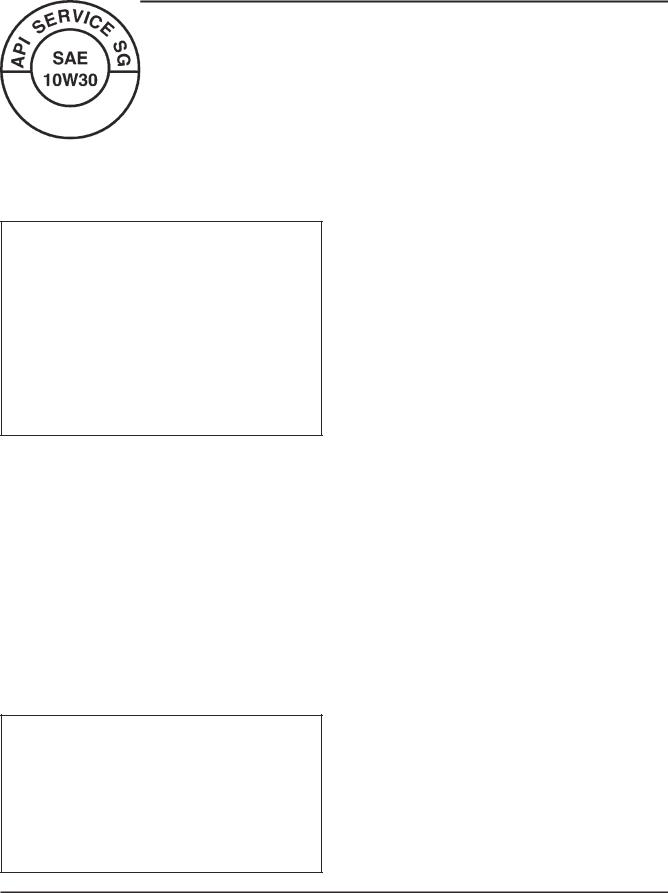
Section 1
Safety and General Information
Oil Recommendations
Using the proper type and weight of oil in the crankcase is extremely important. So is checking oil daily and changing oil regularly. Failure to use the correct oil, or using dirty oil, causes premature engine wear and failure.
Oil Type
Use high-quality detergent oil of API (American
Petroleum Institute) Service Class SG, SH, SJ or higher.
Select the viscosity based on the air temperature at the time of operation as shown in the following table.
Refer to Section 6 - “Lubrication System” for detailed procedures on checking the oil, changing the oil and changing the oil filter.
Fuel Recommendations
WARNING: Explosive Fuel!
Gasoline is extremely flammable and its vapors can explode if ignited. Before servicing the fuel system, make sure there are no sparks, open flames or other sources of ignition nearby as these can ignite gasoline vapors. Disconnect and ground the spark plug leads to prevent the possibility of sparks from the ignition system.
**
*
*Use of synthetic oil having 5W-20 or 5W-30 rating is acceptable, up to 4°C (40°F).
**Synthetic oils will provide better starting in extreme cold (below -23°C (-10°F).
NOTE: Using other than service class SG, SH, SJ or higher oil or extending oil change intervals longer than recommended can cause engine damage.
NOTE: Synthetic oils meeting the listed classifications may be used with oil changes performed at the recommended intervals. However, to allow piston rings to properly seat, a new or rebuilt engine should be operated for at least 50 hours using standard petroleum based oil before switching to synthetic oil.
A logo or symbol on oil containers identifies the API service class and SAE viscosity grade. See Figure 1-3.
Figure 1-3. Oil Container Logo.
General Recommendations
Purchase gasoline in small quantities and store in clean, approved containers. A container with a capacity of 2 gallons or less with a pouring spout is recommended. Such a container is easier to handle and helps eliminate spillage during refueling.
Do not use gasoline left over from the previous season, to minimize gum deposits in your fuel system and to ensure easy starting.
Do not add oil to the gasoline.
Do not overfill the fuel tank. Leave room for the fuel to expand.
Fuel Type
For best results, use only clean, fresh, unleaded gasoline with a pump sticker octane rating of 87 or higher. In countries using the Research method, it should be 90 octane minimum.
Unleaded gasoline is recommended as it leaves less combustion chamber deposits and reduces harmful exhaust emissions. Leaded gasoline is not recommended and must not be used on EFI engines, or on other models where exhaust emissions are regulated.
Gasoline/Alcohol blends
Gasohol (up to 10% ethyl alcohol, 90% unleaded gasoline by volume) is approved as a fuel for Kohler engines. Other gasoline/alcohol blends are not approved.
Gasoline/Ether blends
Methyl Tertiary Butyl Ether (MTBE) and unleaded gasoline blends (up to a maximum of 15% MTBE by volume) are approved as a fuel for Kohler engines. Other gasoline/ether blends are not approved.
1.4
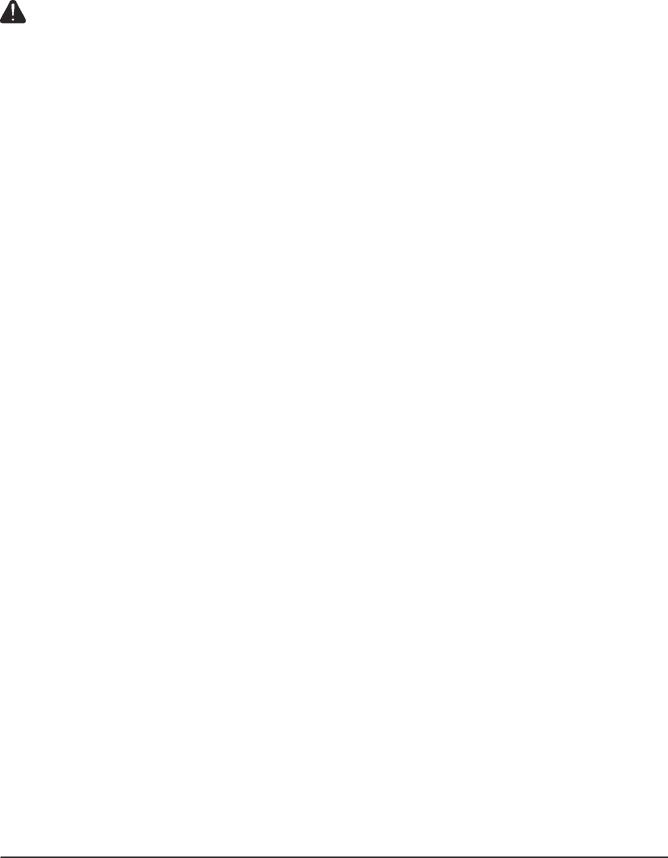
Section 1 |
|
||
Safety and General Information |
|
||
|
|
|
|
Periodic Maintenance Instructions |
|
||
1 |
|||
WARNING: Accidental Starts! |
|||
Disabling engine. Accidental starting can cause severe injury or death. Before working on the engine or equipment, |
|
||
|
|||
disable the engine as follows: 1) Disconnect the spark plug lead(s). 2) Disconnect negative (-) battery cable from battery. |
|
||
Maintenance Schedule
These required maintenance procedures should be performed at the frequency stated in the table. They should also be included as part of any seasonal tune-up.
Frequency |
Maintenance Required |
Refer to: |
|
|
|
|
|
Daily or Before |
• |
Fill fuel tank |
Section 5 |
• |
Check oil level. |
Section 6 |
|
Starting Engine |
• Check air cleaner for dirty1, loose, or damaged parts. |
Section 4 |
|
|
• Check air intake and cooling areas, clean as necessary1. |
Section 4 |
|
Every 25 Hours |
• |
Service precleaner element1. |
Section 4 |
|
• Replace air cleaner element1. |
Section 4 |
|
Every 100 Hours |
• Change oil. (More frequently under severe conditions.) |
Section 6 |
|
|
• Remove cooling shrouds and clean cooling areas1,3. |
Section 4 |
|
|
• Check oil cooler fins, clean as necessary (if equipped). |
Section 6 |
|
|
|
|
|
Every 200 Hours |
• Check spark plug condition and gap. |
Section 8 |
|
• |
Change oil filter. |
Section 6 |
|
|
• Change fuel filter (carbureted engines). |
Section 5 |
|
Every 250 Hours |
• Replace heavy-duty air cleaner element and check inner element1. |
Section 4 |
|
Annually or |
• Have bendix starter drive serviced2. |
Section 8 |
|
Every 500 Hours |
• Have solenoid shift starter disassembled and cleaned2. |
Section 8 |
|
Every 500 Hours |
• Have crankshaft splines lubricated2. |
Section 2 |
|
Every 1500 Hours |
• Replace fuel filter1 (EFI engines). |
Section 5B |
|
¹Perform these maintenance procedures more frequently under extremely dusty, dirty conditions.
²Only requried for Denso starters. Not necessary on Delco starters. Have a Kohler Engine Service Dealer perform this service. ³Cleanout Kits 25 755 20-S (black) or 25 755 21-S (gold) allow cooling areas to be cleaned without removing shrouds.
Storage
If the engine will be out of service for two months or more, use the following storage procedure:
1.Clean the exterior surfaces of the engine. On Electronic Fuel Injected (EFI) engines, avoid spraying water at the wiring harness or any of the electrical components.
2.Change the oil and oil filter while the engine is still warm from operation. See “Change Oil and Oil Filter” in Section 6.
3.The fuel system must be completely emptied, or the gasoline must be treated with a stabilizer to prevent deterioration. If you choose to use a stabilizer, follow the manufacturer’s recommendations, and add the correct amount for the capacity of the fuel system.
Fill the fuel tank with clean, fresh gasoline. Run the engine for 2 to 3 minutes to get stabilized fuel into the rest of the system. Close the fuel shut-off valve when the unit is being stored or transported.
To empty the system, run the engine until the tank and the system are empty.
4.Remove the spark plugs and add one tablespoon of engine oil into each spark plug hole. Install the spark plugs, but do not connect the plug leads.
Crank the engine two or three revolutions.
5.On equipment with an EFI engine, disconnect the battery or use a battery minder to keep the battery charged during storage.
6.Store the engine in a clean, dry place.
1.5

Section 1
Safety and General Information
Dimensions in millimeters.
Inch equivalents shown in [ ].
Figure 1-4. Typical Engine Dimensions CH Series with Standard Flat Air Cleaner.
1.6
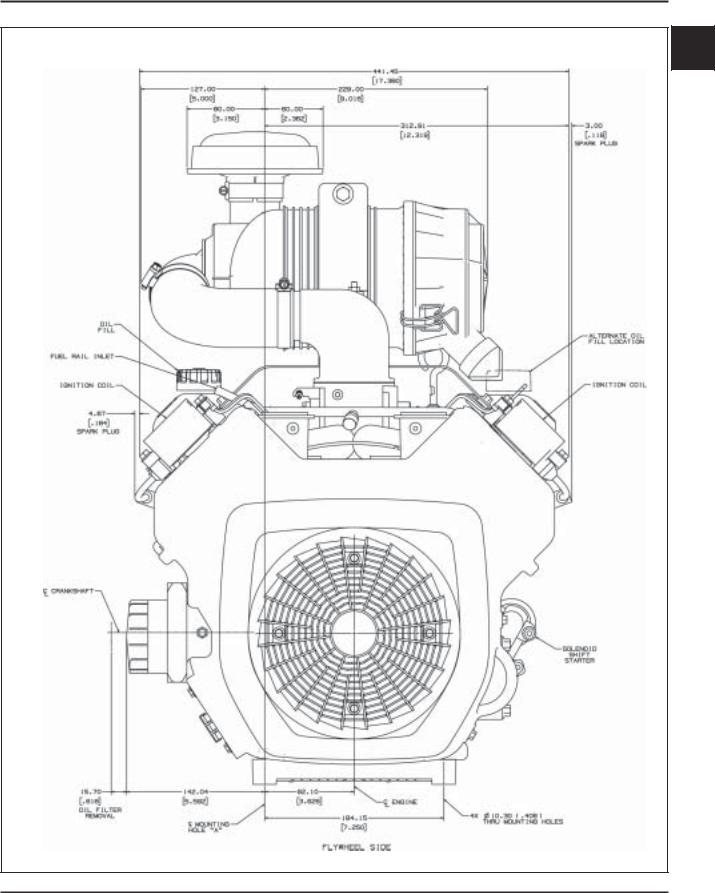
Section 1
Safety and General Information
Dimensions in millimeters. |
1 |
Inch equivalents shown in [ ]. |
Figure 1-5. Typical Engine Dimensions CH EFI Series with Heavy-Duty Air Cleaner.
1.7
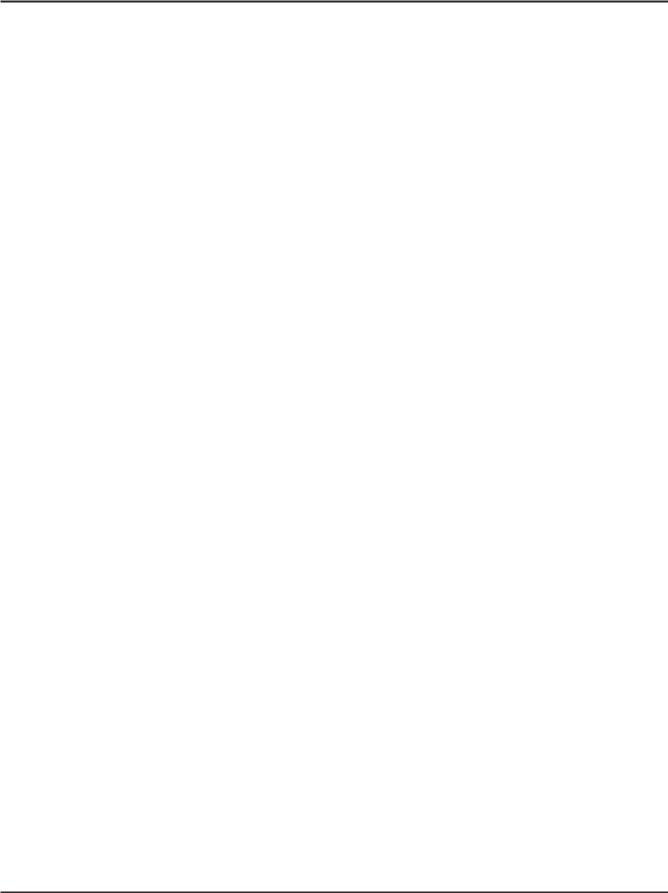
Section 1
Safety and General Information
General Specifications¹
Power (@ 3600 RPM, exceeds Society of Automotive Engineers-Small Engine Test Code J1940.)
CH18 ........................................................................................................................................ |
13.4 kW (18 HP) |
CH20 ........................................................................................................................................ |
14.9 kW (20 HP) |
CH22 ........................................................................................................................................ |
16.4 kW (22 HP) |
CH23 ........................................................................................................................................ |
17.2 kW (23 HP) |
CH25, CH730 .......................................................................................................................... |
18.6 kW (25 HP) |
CH26 ........................................................................................................................................ |
19.4 kW (26 HP) |
CH740 ...................................................................................................................................... |
20.1 kW (27 HP) |
CH745 ...................................................................................................................................... |
20.9 kW (28 HP) |
CH750 ...................................................................................................................................... |
22.3 kW (30 HP) |
Peak Torque |
|
CH18 @ 2200 RPM ................................................................................................................. |
43.6 N·m (32.2 ft. lb.) |
CH20 @ 2400 RPM ................................................................................................................. |
44.3 N·m (32.7 ft. lb.) |
CH22 @ 2400 RPM ................................................................................................................. |
49.1 N·m (36.2 ft. lb.) |
CH23 @ 2400 RPM ................................................................................................................. |
54.1 N·m (37.9 ft. lb.) |
CH25 @ 2200 RPM ................................................................................................................. |
54.0 N·m (39.5 ft. lb.) |
CH730 @ 2400 RPM ............................................................................................................... |
55.4 N·m (40.9 ft. lb.) |
CH26 @ 2800 RPM ................................................................................................................. |
54.2 N·m (40.0 ft. lb.) |
CH740 @ 2400 RPM ............................................................................................................... |
57.3 N·m (42.3 ft. lb.) |
CH745 @ 2600 RPM ............................................................................................................... |
57.9 N·m (42.7 ft. lb.) |
CH750 @ 2400 RPM ............................................................................................................... |
64.4 N·m (47.5 ft. lb.) |
Bore |
|
CH18, CH20, CH22 (624 cc) .................................................................................................. |
77 mm (3.03 in.) |
CH22/23 (674 cc) .................................................................................................................... |
80 mm (3.15 in.) |
CH25, CH26, CH730-750 ....................................................................................................... |
83 mm (3.27 in.) |
Stroke |
|
CH18-745 ................................................................................................................................ |
67 mm (2.64 in.) |
CH750 ...................................................................................................................................... |
69 mm (2.7 in.) |
Displacement |
|
CH18, CH20, CH22 (624 cc) .................................................................................................. |
624 cc (38 cu. in.) |
CH22/23 (674 cc) .................................................................................................................... |
674 cc (41 cu. in.) |
CH25, CH26, CH730-745 ....................................................................................................... |
725 cc (44 cu. in.) |
CH750 ...................................................................................................................................... |
755 cc (46 cu. in.) |
Compression Ratio |
|
CH18, CH20, CH22/23 ........................................................................................................... |
8.5:1 |
CH25, CH26, CH730-745 ....................................................................................................... |
9.0:1 |
CH750 ...................................................................................................................................... |
9.4:1 |
Dry Weight |
|
CH18, CH20, CH22/23 ........................................................................................................... |
41 kg (90 lb.) |
CH25, CH26, CH730-745 ....................................................................................................... |
43 kg (94 lb.) |
CH750 ...................................................................................................................................... |
48 kg (105 lb.) |
Oil Capacity (w/filter) - approximate, |
|
determined by oil filter and oil cooler used ............................................................................. |
1.6-1.8 L (1.7-1.9 U.S. qt.) |
¹Values are in Metric units. Values in parentheses are English equivalents. Lubricate threads with engine oil prior to assembly.
1.8
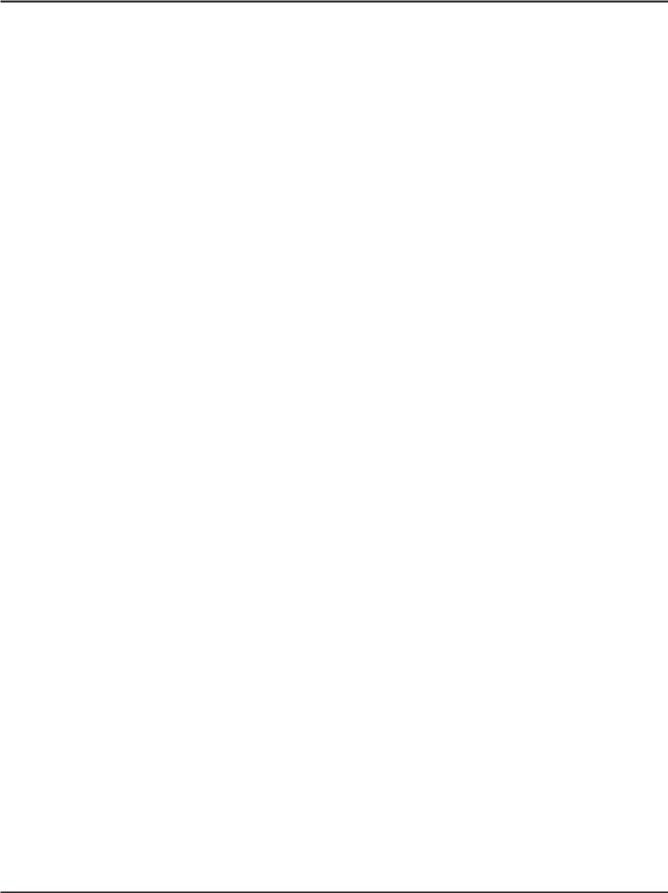
Section 1
Safety and General Information
General Specifications¹ cont. |
|
|
|
1 |
|
Angle of Operation - Maximum (At Full Oil Level) All Directions ................... |
25° |
|
Blower Housing and Sheet Metal |
|
|
|
|
|
M5 Fasteners Torque ................................................................................................ |
6.2 N·m (55 in. lb.) into new holes |
|
|
4.0 N·m (35 in. lb.) into used holes |
|
M6 Fasteners Torque ................................................................................................ |
10.7 N·m (95 in. lb.) into new holes |
|
|
7.3 N·m (65 in. lb.) into used holes |
|
Rectifier-Regulator Fastener Torque ................................................................... |
1.4 N·m (12.6 in. lb.) |
|
Camshaft |
|
|
End Play (With Shim) ............................................................................................ |
0.076/0.127 mm (0.0030/0.0050 in.) |
|
Running Clearance ................................................................................................. |
0.025/0.063 mm (0.0010/0.0025 in.) |
|
Bore I.D. |
|
|
New .................................................................................................................. |
20.000/20.025 mm (0.7874/0.7884 in.) |
|
Max. Wear Limit ............................................................................................. |
20.038 mm (0.7889 in.) |
|
Camshaft Bearing Surface O.D. |
|
|
New .................................................................................................................. |
19.962/19.975 mm (0.7859/0.7864 in.) |
|
Max. Wear Limit ............................................................................................. |
19.959 mm (0.7858 in.) |
|
Carburetor and Intake Manifold |
|
|
Intake Manifold Mounting Fastener Torque |
|
|
Torque in Two Stages ..................................................................................... |
first to 7.4 N·m (66 in. lb.) |
|
|
finally to 9.9 N·m (88 in. lb.) |
|
Carburetor Mounting Screw Torque M6 ............................................................ |
6.2-7.3 N·m (55-65 in. lb.) |
|
Adapter (for Heavy Duty Air Cleaner) Mounting Fastener Torque ................ |
7.3 N·m (65 in. lb.) |
|
Connecting Rod |
|
|
Cap Fastener Torque (torque in increments) |
|
|
8 mm straight shank ............................................................................................ |
22.7 N·m (200 in. lb.) |
|
8 mm step-down .................................................................................................. |
14.7 N·m (130 in. lb.) |
|
6 mm straight shank ............................................................................................ |
11.3 N·m (100 in. lb.) |
|
Connecting Rod-to-Crankpin Running Clearance |
|
|
New .................................................................................................................. |
0.030/0.055 mm (0.0012/0.0022 in.) |
|
Max. Wear Limit ............................................................................................. |
0.070 mm (0.0028 in.) |
|
Connecting Rod-to-Crankpin Side Clearance .................................................... |
0.26/0.63 mm (0.0102/0.0248 in.) |
|
Connecting Rod-to-Piston Pin Running Clearance ........................................... |
0.015/0.028 mm (0.0006/0.0011 in.) |
|
Piston Pin End I.D. |
|
|
New .................................................................................................................. |
17.015/17.023 mm (0.6699/0.6702 in.) |
|
Max. Wear Limit ............................................................................................. |
17.036 mm (0.6707 in.) |
|
¹Values are in Metric units. Values in parentheses are English equivalents. Lubricate threads with engine oil prior to assembly.
1.9
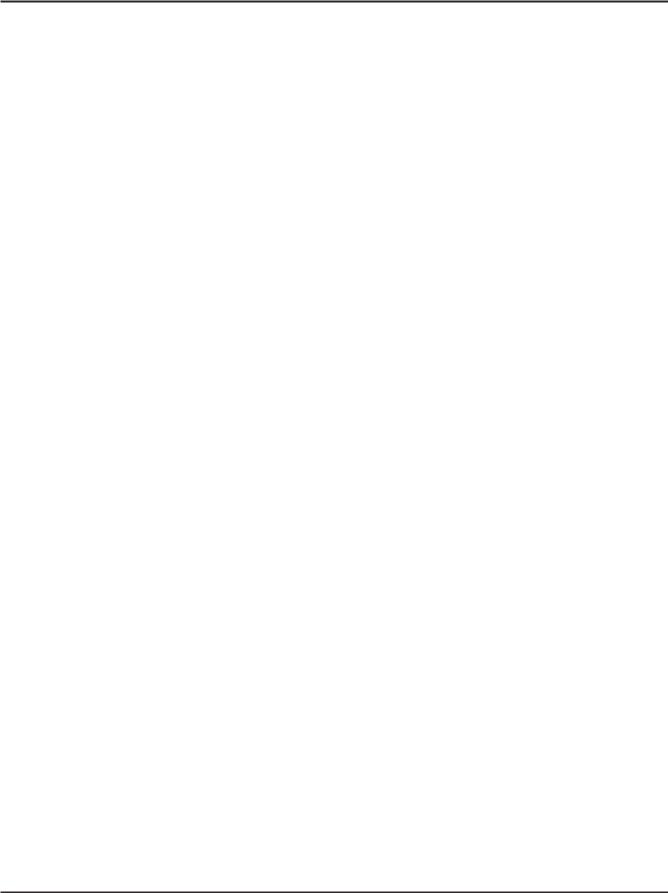
Section 1
Safety and General Information
Crankcase |
|
Governor Cross Shaft Bore I.D. |
|
6 mm Shaft |
|
New .................................................................................................................. |
6.025/6.050 mm (0.2372/0.2382 in.) |
Max. Wear Limit ............................................................................................. |
6.063 mm (0.2387 in.) |
8 mm Shaft |
|
New .................................................................................................................. |
8.025/8.075 mm (0.3159/0.3179 in.) |
Max. Wear Limit ............................................................................................. |
8.088 mm (0.3184 in.) |
Breather Cover Fastener Torque .......................................................................... |
7.3 N·m (65 in. lb.) |
Oil Drain Plug Torque ............................................................................................ |
13.6 N·m (10 ft. lb.) |
Closure Plate |
|
Closure Plate Fastener Torque .............................................................................. |
24.4 N·m (216 in. lb.) |
Crankshaft |
|
End Play (Free) ........................................................................................................ |
0.070/0.590 mm (0.0028/0.0230 in.) |
End Play (With Thrust Bearing Components) ................................................... |
0.070/0.270 mm (0.0028/0.0100 in.) |
Except CH25 Engines Below Serial No. 2403500008 .......................................... |
0.050/0.750 mm (0.0020/0.0295 in.) |
Crankshaft Bore (In Crankcase) |
|
New .................................................................................................................. |
40.965/41.003 mm (1.6128/1.6143 in.) |
Max. Wear Limit ............................................................................................. |
41.016 mm (1.6148 in.) |
Crankshaft to Sleeve Bearing (Crankcase) |
|
Running Clearance - New ............................................................................ |
0.03/0.09 mm (0.0012/0.0035 in.) |
Crankshaft Bore (In Closure Plate) - New .......................................................... |
40.987/40.974 mm (1.6136/1.6131 in.) |
Crankshaft Bore (In Closure Plate)-to-Crankshaft |
|
Running Clearance - New ............................................................................ |
0.039/0.074 mm (0.0015/0.0029 in.) |
Flywheel End Main Bearing Journal |
|
O.D. - New ....................................................................................................... |
40.913/40.935 mm (1.6107/1.6116 in.) |
O.D. - Max. Wear Limit .................................................................................. |
40.84 mm (1.608 in.) |
Max. Taper ....................................................................................................... |
0.022 mm (0.0009 in.) |
Max. Out-of-Round ........................................................................................ |
0.025 mm (0.0010 in.) |
Closure Plate End Main Bearing Journal |
|
O.D. - New ....................................................................................................... |
40.913/40.935 mm (1.6107/1.6116 in.) |
O.D. - Max. Wear Limit .................................................................................. |
40.84 mm (1.608 in.) |
Max. Taper ....................................................................................................... |
0.022 mm (0.0009 in.) |
Max. Out-of-Round ........................................................................................ |
0.025 mm (0.0010 in.) |
Connecting Rod Journal |
|
O.D. - New ....................................................................................................... |
35.955/35.973 mm (1.4156/1.4163 in.) |
O.D. - Max. Wear Limit .................................................................................. |
35.94 mm (1.415 in.) |
Max. Taper ....................................................................................................... |
0.018 mm (0.0007 in.) |
Max. Out-of-Round ........................................................................................ |
0.025 mm (0.0010 in.) |
1.10
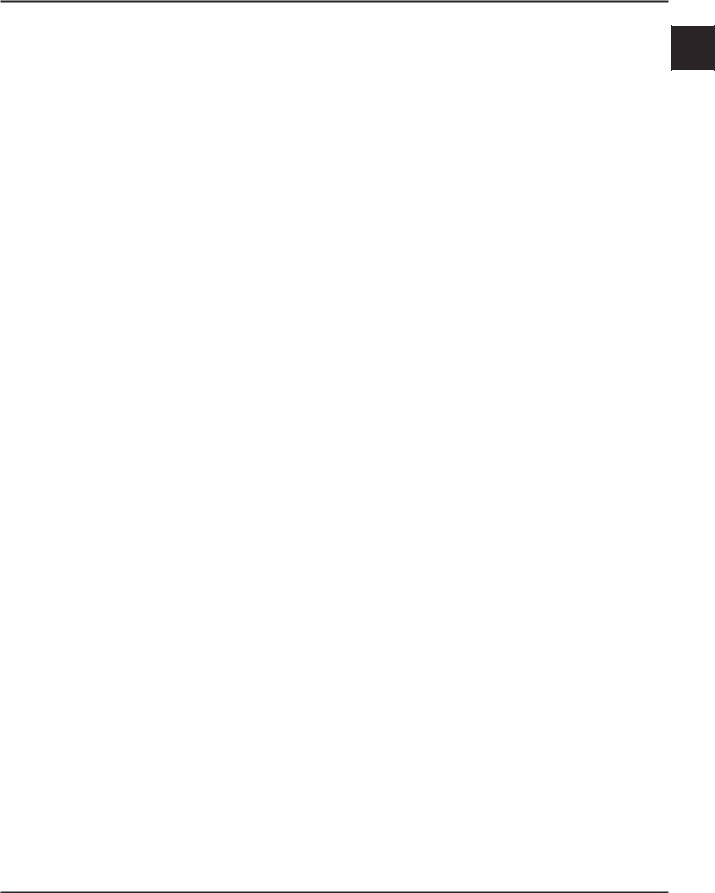
|
Section 1 |
|
|
Safety and General Information |
|
Crankshaft cont. |
|
|
Crankshaft T.I.R. |
|
|
PTO End, Crank in Engine ............................................................................. |
0.279 mm (0.0110 in.) |
1 |
Entire Crank, in V-Blocks .............................................................................. |
0.10 mm (0.0039 in.) |
|
Cylinder Bore |
|
|
Cylinder Bore I.D. |
|
|
New - CH18, CH20, CH22 (624 cc) ............................................................... |
77.000/77.025 mm (3.0315/3.0325 in.) |
|
New - CH22/23 (674 cc) ................................................................................. |
80.000/80.025 mm (3.1496/3.1506 in.) |
|
New - CH25, CH26, CH730-750 ................................................................... |
82.988/83.013 mm (3.2672/3.2682 in.) |
|
Max. Wear Limit - CH18, CH20, CH22 (624 cc) .......................................... |
77.063 mm (3.0340 in.) |
|
Max. Wear Limit - CH22/23 (674 cc) ............................................................ |
80.065 mm (3.1522 in.) |
|
Max. Wear Limit - CH25, CH26, CH730-750 .............................................. |
83.051 mm (3.2697 in.) |
|
Max. Out-of-Round ........................................................................................ |
0.12 mm (0.0047 in.) |
|
Max. Taper ....................................................................................................... |
0.05 mm (0.0020 in.) |
|
Cylinder Head |
|
|
Cylinder Head Fastener Torque |
|
|
Hex Flange Nut - Torque in Two Stages ...................................................... |
first to 16.9 N·m (150 in. lb.) |
|
|
finally to 33.9 N·m (300 in. lb.) |
|
Head Bolt - Torque in Two Stages ................................................................ |
first to 22.6 N·m (200 in. lb.) |
|
|
finally to 41.8 N·m (370 in. lb.) |
|
Max. Out-of-Flatness .............................................................................................. |
0.076 mm (0.003 in.) |
|
Rocker Arm Screw Torque .................................................................................... |
11.3 N·m (100 in. lb.) |
|
Fan/Flywheel |
|
|
Fan Fastener Torque ............................................................................................... |
9.9 N·m (88 in. lb.) |
|
Flywheel Retaining Screw Torque ....................................................................... |
66.4 N·m (49 ft. lb.) |
|
Governor |
|
|
Governor Cross Shaft-to-Crankcase Running Clearance |
|
|
6 mm Shaft ............................................................................................................. |
0.013/0.075 mm (0.0005/0.0030 in.) |
|
8 mm Shaft ............................................................................................................. |
0.025/0.126 mm (0.0009/0.0049 in.) |
|
Governor Cross Shaft O.D. |
|
|
6 mm Shaft |
|
|
New .................................................................................................................. |
5.975/6.012 mm (0.2352/0.2367 in.) |
|
Max. Wear Limit ............................................................................................. |
5.962 mm (0.2347 in.) |
|
8 mm Shaft |
|
|
New .................................................................................................................. |
7.949/8.000 mm (0.3129/0.3149 in.) |
|
Max. Wear Limit ............................................................................................. |
7.936 mm (0.3124 in.) |
|
Governor Gear Shaft-to-Governor Gear Running Clearance ......................... |
0.015/0.140 mm (0.0006/0.0055 in.) |
|
Governor Gear Shaft O.D. |
|
|
New .................................................................................................................. |
5.990/6.000 mm (0.2358/0.2362 in.) |
|
Max. Wear Limit ............................................................................................. |
5.977 mm (0.2353 in.) |
|
Governor Lever Nut Torque ................................................................................. |
6.8 N·m (60 in. lb.) |
|
1.11
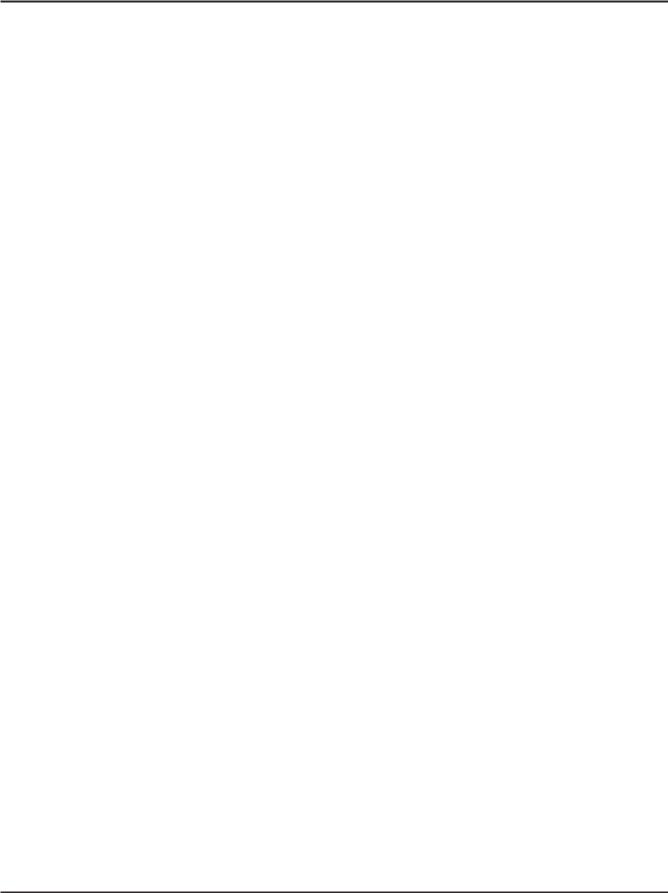
Section 1
Safety and General Information
Ignition |
|
Spark Plug Type (Champion® or Equivalent) ..................................................... |
RC12YC, XC12YC, or Platinum 3071 |
Spark Plug Gap ....................................................................................................... |
0.76 mm (0.030 in.) |
Spark Plug Torque .................................................................................................. |
24.4-29.8 N·m (18-22 ft. lb.) |
Ignition Module Air Gap ....................................................................................... |
0.28/0.33 mm (0.011/0.013 in.) |
Ignition Module Fastener Torque ......................................................................... |
4.0-6.2 N·m (35-55 in. lb.) |
Speed Sensor Air Gap (EFI engines) ..................................................................... |
1.50 ± 0.25 mm (0.059 ± 0.010 in.) |
Muffler |
|
Muffler Retaining Nut Torque .............................................................................. |
24.4 N·m (216 in. lb.) |
Oil Filter |
|
Oil Filter Torque ...................................................................................................... |
3/4-1 turn after gasket contact |
Oil Cooler |
|
Oil Cooler/Adapter Nipple Torque ...................................................................... |
27 N·m (20 ft. lb.) |
Piston, Piston Rings, and Piston Pin |
|
Piston-to-Piston Pin Running Clearance ............................................................ |
0.006/0.017 mm (0.0002/0.0007 in.) |
Piston Pin Bore I.D. |
|
New .................................................................................................................. |
17.006/17.012 mm (0.6695/0.6698 in.) |
Max. Wear Limit ............................................................................................. |
17.025 mm (0.6703 in.) |
Piston Pin O.D. |
|
New .................................................................................................................. |
16.995/17.000 mm (0.6691/0.6693 in.) |
Max. Wear Limit ............................................................................................. |
16.994 mm (0.6691 in.) |
Top Compression Ring-to-Groove Side Clearance |
|
CH18, CH20, CH22 (624 cc) ........................................................................... |
0.040/0.080 mm (0.0016/0.0031 in.) |
CH22/23 (674 cc) ............................................................................................. |
0.030/0.076 mm (0.0012/0.0030 in.) |
CH25, CH26, CH730-750 ............................................................................... |
0.025/0.048 mm (0.0010/0.0019 in.) |
Middle Compression Ring-to-Groove Side Clearance |
|
CH18, CH20, CH22 (624 cc) ........................................................................... |
0.040/0.080 mm (0.0016/0.0031 in.) |
CH22/23 (674 cc) ............................................................................................. |
0.030/0.076 mm (0.0012/0.0030 in.) |
CH25, CH26, CH730-750 ............................................................................... |
0.015/0.037 mm (0.0006/0.0015 in.) |
Oil Control Ring-to-Groove Side Clearance |
|
CH18, CH20, CH22 (624 cc) ........................................................................... |
0.060/0.202 mm (0.0024/0.0080 in.) |
CH22/23 (674 cc) ............................................................................................. |
0.046/0.196 mm (0.0018/0.0077 in.) |
CH25, CH26, CH730-750 ............................................................................... |
0.026/0.176 mm (0.0010/0.0070 in.) |
1.12
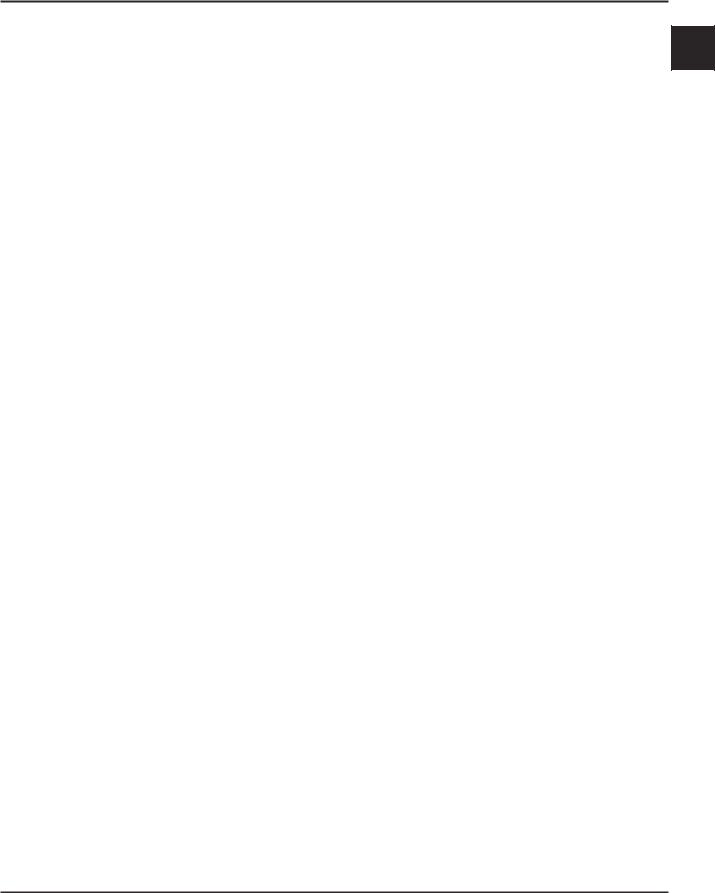
|
Section 1 |
|
|
Safety and General Information |
|
Piston, Piston Rings, and Piston Pin cont. |
|
|
Top and Center Compression Ring End Gap |
|
|
New Bore - CH18, CH20, CH22 (624 cc) ...................................................... |
0.25/0.45 mm (0.0098/0.0177 in.) |
1 |
New Bore - CH22/23 (674 cc) ........................................................................ |
0.18/0.46 mm (0.0071/0.0181 in.) |
|
New Bore - CH25, CH26, CH730-745 .......................................................... |
0.25/0.56 mm (0.0100/0.0224 in.) |
|
Used Bore (Max.) - CH18, CH20, CH22 (624 cc) .......................................... |
0.77 mm (0.030 in.) |
|
Used Bore (Max.) - CH22/23 (674 cc) ............................................................ |
0.80 mm (0.0315 in.) |
|
Used Bore (Max.) - CH25, CH26, CH730-750 .............................................. |
0.94 mm (0.037 in.) |
|
Piston Thrust Face O.D.² |
|
|
New - CH18, CH20, CH22 (624 cc) ............................................................... |
76.967/76.985 mm (3.0302/3.0309 in.) |
|
New - CH22/23 (674 cc) ................................................................................. |
79.963/79.979 mm (3.1481/3.1488 in.) |
|
New - CH25, CH26, CH730-750 ................................................................... |
82.986 mm (3.2671 in.) |
|
Max. Wear Limit - CH18, CH20, CH22 (624 cc) .......................................... |
76.840 mm (3.0252 in.) |
|
Max. Wear Limit - CH22 (674 cc) ................................................................. |
79.831 mm (3.1430 in.) |
|
Max. Wear Limit - CH25, CH26, CH730-750 .............................................. |
82.841 mm (3.2614 in.) |
|
Piston Thrust Face-to-Cylinder Bore² Running Clearance |
|
|
New - CH18, CH20, CH22 (624 cc) ............................................................... |
0.014/0.057 mm (0.0005/0.0022 in.) |
|
New - CH22/23 (674 cc) ................................................................................. |
0.021/0.062 mm (0.0008/0.0024 in.) |
|
New - CH25, CH26, CH730-750 ................................................................... |
0.001/0.045 mm (0.039/0.0018 in.) |
|
Speed Control Bracket |
|
|
Fastener Torque ....................................................................................................... |
10.7 N·m (95 in. lb.) into new holes |
|
|
7.3 N·m (65 in. lb.) into used holes |
|
Starter Assembly |
|
|
Thru Bolt Torque |
|
|
UTE/Johnson Electric, Eaton (Inertia Drive) ............................................... |
4.5-5.7 N·m (40-50 in. lb.) |
|
Nippondenso (Solenoid Shift) ...................................................................... |
4.5-7.5 N·m (40-84 in. lb.) |
|
Delco-Remy (Solenoid Shift) ......................................................................... |
5.6-9.0 N·m (49-79 in. lb.) |
|
Mounting Screw Torque (All) ............................................................................... |
15.3 N·m (135 in. lb.) |
|
Brush Holder Mounting Screw Torque |
|
|
Delco-Remy Starter ........................................................................................ |
2.5-3.3 N·m (22-29 in. lb.) |
|
Solenoid (Starter) |
|
|
Mounting Hardware Torque |
|
|
Nippondenso Starter ..................................................................................... |
6.0-9.0 N·m (53-79 in. lb.) |
|
Delco-Remy Starter ........................................................................................ |
4.0-6.0 N·m (35-53 in. lb.) |
|
Nut, Positive (+) Brush Lead Torque |
|
|
Nippondenso Starter ..................................................................................... |
8.0-12.0 N·m (71-106 in. lb.) |
|
Delco-Remy Starter ........................................................................................ |
8.0-11.0 N·m (71-97 in. lb.) |
|
Stator |
|
|
Mounting Screw Torque ........................................................................................ |
6.2 N·m (55 in. lb.) |
|
²Measure 6 mm (0.236 in.) above the bottom of the piston skirt at right angles to the piston pin.
1.13
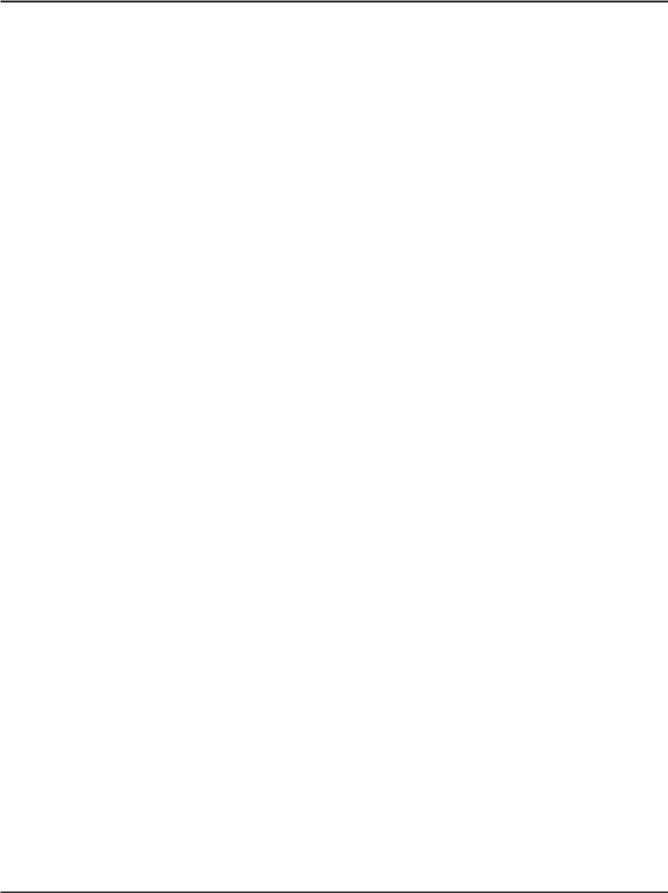
Section 1
Safety and General Information
Valve Cover |
|
Valve Cover Fastener Torque |
|
Gasket Style Cover ................................................................................................. |
3.4 N·m (30 in. lb.) |
Black O-Ring Style Cover |
|
w/Shoulder Screws ........................................................................................ |
5.6 N·m (50 in. lb.) |
w/Flange Screws and Spacers ...................................................................... |
9.9 N·m (88 in. lb.) |
Yellow or Brown O-Ring Style Cover w/Integral Metal Spacers .................... |
6.2 N·m (55 in. lb.) |
Valves and Valve Lifters |
|
Hydraulic Valve Lifter to Crankcase Running Clearance ................................ |
0.0241/0.0501 mm (0.0009/0.0020 in.) |
Intake Valve Stem-to-Valve Guide Running Clearance ................................... |
0.038/0.076 mm (0.0015/0.0030 in.) |
Exhaust Valve Stem-to-Valve Guide Running Clearance ................................ |
0.050/0.088 mm (0.0020/0.0035 in.) |
Intake Valve Guide I.D. |
|
New .................................................................................................................. |
7.038/7.058 mm (0.2771/0.2779 in.) |
Max. Wear Limit ............................................................................................. |
7.134 mm (0.2809 in.) |
Exhaust Valve Guide I.D. |
|
New .................................................................................................................. |
7.038/7.058 mm (0.2771/0.2779 in.) |
Max. Wear Limit ............................................................................................. |
7.159 mm (0.2819 in.) |
Valve Guide Reamer Size |
|
Standard .......................................................................................................... |
7.048 mm (0.2775 in.) |
0.25 mm O.S..................................................................................................... |
7.298 mm (0.2873 in.) |
Intake Valve Minimum Lift ................................................................................... |
8.07 mm (0.3177 in.) |
Exhaust Valve Minimum Lift ............................................................................... |
8.07 mm (0.3177 in.) |
Nominal Valve Seat Angle .................................................................................... |
45° |
1.14
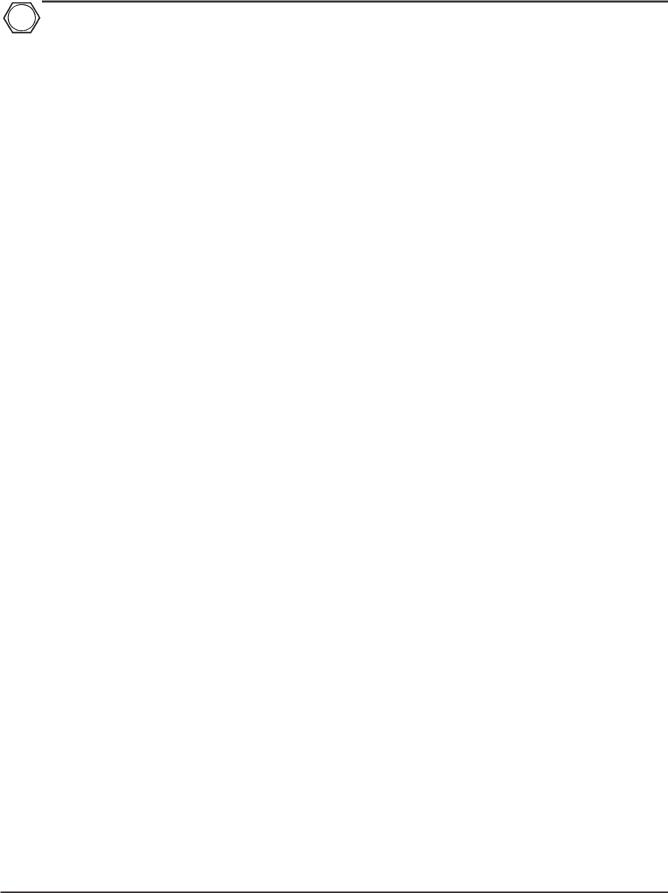
Section 1
Safety and General Information
General Torque Values |
|
|
|
|
|
|
|
|
|
|
|
|||
|
|
|
|
|
|
|
|
|
|
1 |
||||
Metric Fastener Torque Recommendations for Standard Applications |
|
|
|
|
|
|||||||||
|
|
|
|
|
|
|
|
|
||||||
|
|
|
|
|
|
|
|
|
||||||
Tightening Torque: N·m (in. lb.) + or - 10% |
|
|
|
|
|
|
|
|
||||||
|
|
|
|
|
Property Class |
|
|
|
|
Noncritical |
|
|||
|
|
|
|
|
|
|
|
|
|
|
Fasteners |
|
||
|
|
|
|
|
|
|
|
|
|
|
Into Aluminum |
|
||
|
4.8 |
|
|
|
|
|
|
|
|
|
|
|
|
|
Size |
|
|
|
|
|
|
|
|
|
|
|
|
|
|
M4 |
1.2 |
(11) |
1.7 |
(15) |
2.9 |
(26) |
4.1 |
(36) |
5.0 |
(44) |
2.0 |
(18) |
|
|
M5 |
2.5 |
(22) |
3.2 |
(28) |
5.8 |
(51) |
8.1 |
(72) |
9.7 |
(86) |
4.0 |
(35) |
|
|
M6 |
4.3 |
(38) |
5.7 |
(50) |
9.9 |
(88) |
14.0 |
(124) |
16.5 |
(146) |
6.8 |
(60) |
|
|
M8 |
10.5 |
(93) |
13.6 |
(120) |
24.4 |
(216) |
33.9 |
(300) |
40.7 |
(360) |
17.0 |
(150) |
|
|
|
|
|
|
|
|
|
|
|
||||||
Tightening Torque: N·m (ft. lb.) + or - 10% |
|
|
|
|
|
|
|
|
||||||
|
|
|
|
|
Property Class |
|
|
|
|
Noncritical |
|
|||
|
|
|
|
|
|
|
|
|
|
|
Fasteners |
|
||
|
|
|
|
|
|
|
|
|
|
|
Into Aluminum |
|
||
M10 |
21.7 (16) |
27.1 (20) |
47.5 (35) |
66.4 (49) |
81.4 (60) |
33.9 (25) |
|
|
||||||
M12 |
36.6 (27) |
47.5 (35) |
82.7 (61) |
116.6 (86) |
139.7 (103) |
61.0 (45) |
|
|
||||||
M14 |
58.3 (43) |
76.4 (55) |
131.5 (97) |
184.4 (136) |
219.7 (162) |
94.9 (70) |
|
|
||||||
|
|
|
|
|
|
|
|
|
|
|
|
|
|
|
1.15
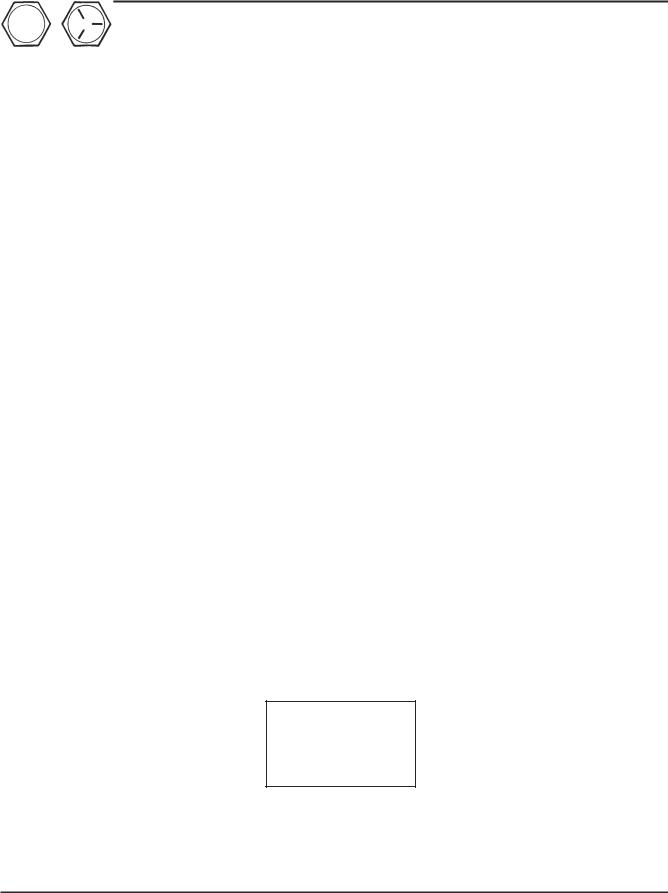
Section 1
Safety and General Information
English Fastener Torque Recommendations for Standard Applications
Tightening Torque: N·m (in. lb.) + or - 20% |
|
|
|
|
|||
|
|
|
|
|
|
|
|
Bolts, Screws, Nuts and Fasteners |
|
|
|
|
Grade 2 or 5 |
||
Assembled Into Cast Iron or Steel |
|
|
|
|
|||
|
|
|
|
Fasteners Into |
|||
|
|
|
|
|
|
|
|
|
|
|
|
|
|
|
Aluminum |
|
Grade 2 |
Grade 5 |
Grade 8 |
|
|||
|
|
|
|
|
|
|
|
Size |
|
|
|
|
|
|
|
8-32 |
2.3 (20) |
2.8 (25) |
--------- |
|
2.3 (20) |
||
10-24 |
3.6 (32) |
4.5 (40) |
--------- |
|
3.6 (32) |
||
10-32 |
3.6 (32) |
4.5 (40) |
--------- |
|
--------- |
||
1/4-20 |
7.9 (70) |
13.0 (115) |
18.7 (165) |
7.9 (70) |
|||
1/4-28 |
9.6 (85) |
15.8 (140) |
22.6 (200) |
--------- |
|||
5/16-18 |
17.0 (150) |
28.3 (250) |
39.6 (350) |
17.0 (150) |
|||
5/16-24 |
18.7 (165) |
30.5 (270) |
--------- |
|
--------- |
||
3/8-16 |
29.4 (260) |
--------- |
|
--------- |
--------- |
||
3/8-24 |
33.9 (300) |
--------- |
|
--------- |
--------- |
||
|
|
|
|
|
|
|
|
Tightening Torque: N·m (ft. lb.) + or - 20% |
|
|
|
|
|||
|
|
|
|
|
|
|
|
Size |
|
|
|
|
|
|
|
5/16-24 |
--------- |
|
---------- |
40.7 |
(30) |
--------- |
|
3/8-16 |
--------- |
|
47.5 |
(35) |
67.8 |
(50) |
--------- |
3/8-24 |
--------- |
|
54.2 |
(40) |
81.4 |
(60) |
--------- |
7/16-14 |
47.5 |
(35) |
74.6 |
(55) |
108.5 (80) |
--------- |
|
7/16-20 |
61.0 |
(45) |
101.7 |
(75) |
142.4 |
(105) |
--------- |
1/2-13 |
67.8 |
(50) |
108.5 |
(80) |
155.9 |
(115) |
--------- |
1/2-20 |
94.9 |
(70) |
142.4 |
(105) |
223.7 |
(165) |
--------- |
9/16-12 |
101.7 |
(75) |
169.5 |
(125) |
237.3 |
(175) |
--------- |
9/16-18 |
135.6 |
(100) |
223.7 |
(165) |
311.9 |
(230) |
--------- |
5/8-11 |
149.2 |
(110) |
244.1 |
(180) |
352.6 |
(260) |
--------- |
5/8-18 |
189.8 |
(140) |
311.9 |
(230) |
447.5 |
(330) |
--------- |
3/4-10 |
199.3 |
(150) |
332.2 |
(245) |
474.6 |
(350) |
--------- |
3/4-16 |
271.2 |
(200) |
440.7 |
(325) |
637.3 |
(470) |
--------- |
|
|
|
|
|
|
|
|
Torque
Conversions
N·m = in. lb. x 0.113 N·m = ft. lb. x 1.356 in. lb. = N·m x 8.85 ft. lb. = N·m x 0.737
1.16
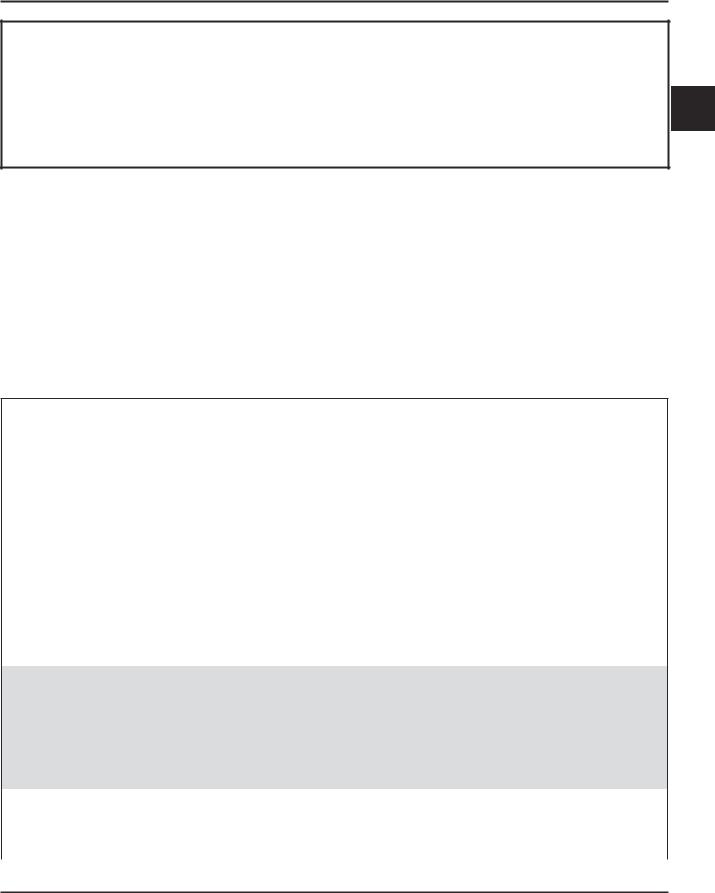
Section 2
Tools & Aids
Section 2 |
|
Tools & Aids |
2 |
Certain quality tools are designed to help you perform specific disassembly, repair, and reassembly procedures. By using tools designed for the job, you can properly service engines easier, faster, and safer! In addition, you’ll increase your service capabilities and customer satisfaction by decreasing engine downtime.
Here is the list of tools and their source. |
|
|
Separate Tool Suppliers: |
|
|
Kohler Tools |
SE Tools |
Design Technology Inc. |
Contact your source |
415 Howard St. |
768 Burr Oak Drive |
of supply. |
Lapeer, MI 48446 |
Westmont, IL 60559 |
|
Phone 810-664-2981 |
Phone 630-920-1300 |
|
Toll Free 800-664-2981 |
|
|
Fax 810-664-8181 |
|
Tools
Description |
Source/Part No. |
|
|
|
|
Balance Gear Timing Tool (K & M Series) |
Kohler 25 455 06-S |
|
To hold balance gears in timed position when assembling engine. |
(Formerly Y-357) |
|
|
|
|
Camshaft Endplay Plate |
SE Tools KLR-82405 |
|
For checking camshaft endplay. |
||
|
||
|
|
|
Cylinder Leakdown Tester |
Kohler 25 761 05-S |
|
For checking combustion retention and if cylinder, piston, rings, or valves are worn. |
||
|
||
|
|
|
Electronic Fuel Injection (EFI) Diagnostic Software |
Kohler 25 761 23-S |
|
Use with Laptop or Desktop PC. |
|
|
|
|
|
EFI Service Kit |
Kohler 24 761 01-S |
|
For troubleshooting and setting up an EFI engine. |
||
|
||
Individual Components Available |
Design Technology Inc. |
|
Pressure Tester |
DTI-019 |
|
Noid Light |
DTI-021 |
|
90° Adapter |
DTI-023 |
|
Oetiker Clamp Pliers |
DTI-025 |
|
Code Plug, Red Wire |
DTI-027 |
|
Code Plug, Blue Wire |
DTI-029 |
|
|
|
|
Flywheel Holding Tool (CS Series) |
SE Tools KLR-82407 |
|
|
|
|
Flywheel Puller |
SE Tools KLR-82408 |
|
To remove flywheel from engine. |
||
|
||
|
|
2.1
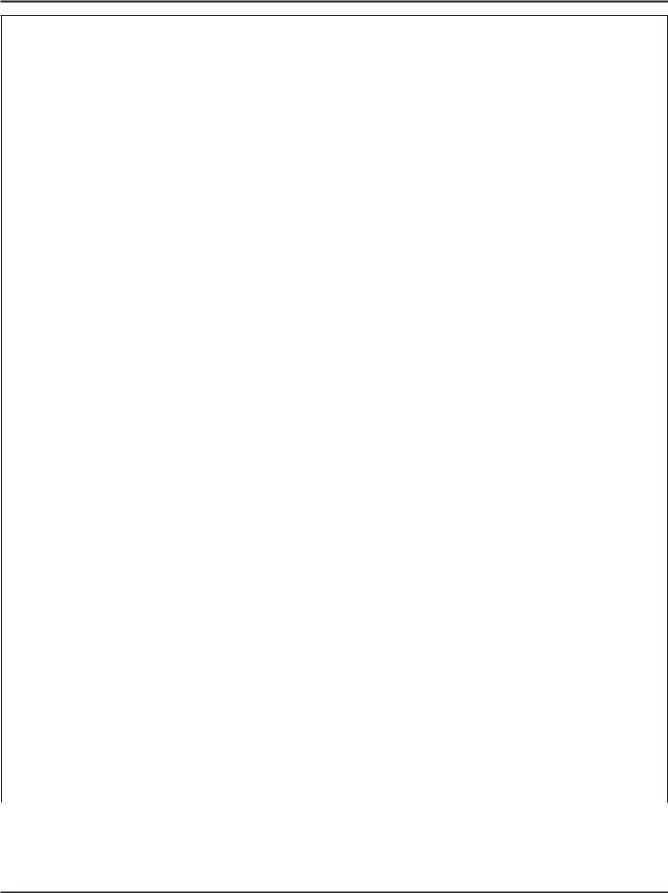
Section 2
Tools & Aids
Tools (cont.)
Description |
Source/Part No. |
|
|
|
|
Flywheel Strap Wrench |
SE Tools KLR-82409 |
|
To hold flywheel during removal. |
||
|
||
|
|
|
Hydraulic Valve Lifter Tool |
Kohler 25 761 38-S |
|
To remove and install hydraulic lifters. |
||
|
||
|
|
|
Ignition System Tester |
|
|
For testing output on all systems, except CD. |
Kohler 25 455 01-S |
|
For testing output on capacitive discharge (CD) ignition system. |
Kohler 24 455 02-S |
|
|
|
|
Offset Wrench (K & M Series) |
SE Tools KLR-82410 |
|
To remove and reinstall cylinder barrel retaining nuts. |
||
|
||
|
|
|
Oil Pressure Test Kit |
Kohler 25 761 06-S |
|
To test and verify oil pressure. |
||
|
||
|
|
|
Rectifier-Regulator Tester (120 volt current) |
Kohler 25 761 20-S |
|
Rectifier-Regulator Tester (240 volt current) |
Kohler 25 761 41-S |
|
Used to test rectifier-regulators. |
|
|
|
|
|
Individual Components Available |
Design Technology Inc. |
|
CS-PRO Regulator Test Harness |
DTI-031 |
|
Special Regulator Test Harness with Diode |
DTI-033 |
|
|
|
|
Spark Advance Module (SAM) Tester |
Kohler 25 761 40-S |
|
To test the SAM (ASAM and DSAM) on engines with SMART-SPARK™. |
||
|
||
Starter Brush Holding Tool (Solenoid Shift) |
SE Tools KLR-82416 |
|
To hold brushes during servicing. |
||
|
||
|
|
|
Starter Retaining Ring Tool (Inertia Drive) |
Kohler 25 761 18-S |
|
To remove and reinstall drive retaining rings (excluding FASCO starters). |
||
|
||
|
|
|
Starter Servicing Kit (All Starters) |
SE Tools KLR-82411 |
|
To remove and reinstall drive retaining rings and brushes. |
||
|
||
|
|
|
Individual Component Available |
SE Tools KLR-82416 |
|
Starter Brush Holding Tool (Solenoid Shift) |
||
|
||
|
|
|
Tachometer (Digital Inductive) |
Design Technology Inc. |
|
For checking operating speed (RPM) of an engine. |
DTI-110 |
|
|
|
|
Vacuum/Pressure Tester |
Kohler 25 761 22-S |
|
Alternative to a water manometer. |
||
|
||
|
|
|
Valve Guide Reamer (K & M Series) |
SE Tools KLR-82413 |
|
For sizing valve guides after installation. |
||
|
||
|
|
|
Valve Guide Service Kit (Courage, Aegis, Command, OHC) |
SE Tools KLR-82415 |
|
For servicing worn value guides. |
||
|
||
|
|
2.2

|
Section 2 |
|||
|
Tools & Aids |
|||
|
|
|
|
|
|
|
|
|
|
Aids |
|
|
|
|
|
|
|
||
Description |
Source/Part No. |
|
||
|
|
|
|
|
Camshaft Lubricant (Valspar ZZ613) |
Kohler 25 357 14-S |
|
|
|
2 |
||||
|
|
|
||
Dielectric Grease (GE/Novaguard G661) |
Kohler 25 357 11-S |
|
||
|
|
|||
|
|
|
||
Dielectric Grease (Fel-Pro) |
Lubri-Sel |
|
||
|
|
|
||
Electric Starter Drive Lubricant (Inertia Drive) |
Kohler 52 357 01-S |
|
||
|
|
|
||
Electric Starter Drive Lubricant (Solenoid Shift) |
Kohler 52 357 02-S |
|
||
|
|
|
||
RTV Silicone Sealant |
Kohler 25 597 07-S |
|
||
Loctite® 5900 Heavy Body in 4 oz aerosol dispenser. |
|
|
|
|
Only oxime-based, oil resistant RTV sealants, such as those listed, are approved for use. |
|
|
|
|
Loctite® Nos. 5900 or 5910 are recommended for best sealing characteristics. |
|
|
|
|
Loctite® 5910 |
|
|
|
|
Loctite® Ultra Black 598 |
|
|
|
|
Loctite® Ultra Blue 587 |
|
|
|
|
Loctite® Ultra Copper |
|
|
|
|
|
|
|
||
Spline Drive Lubricant |
Kohler 25 357 12-S |
|
||
|
|
|
|
|
2.3
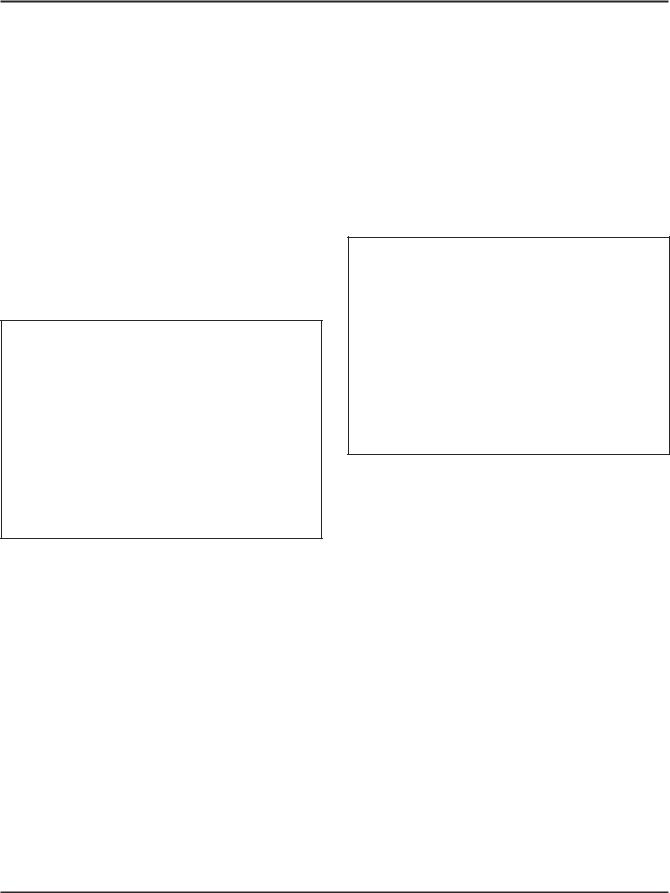
Section 2
Tools & Aids
Special Tools You Can Make
Flywheel Holding Tool
A flywheel holding tool can be made out of an old junk flywheel ring gear as shown in Figure 2-1, and used in place of a strap wrench.
1.Using an abrasive cut-off wheel, cut out a six tooth segment of the ring gear as shown.
2.Grind off any burrs or sharp edges.
3.Invert the segment and place it between the ignition bosses on the crankcase so that the tool teeth engage the flywheel ring gear teeth. The bosses will lock the tool and flywheel in position for loosening, tightening or removing with a puller.
Figure 2-1. Flywheel Holding Tool.
Rocker Arm/Crankshaft Tool
A spanner wrench to lift the rocker arms or turn the crankshaft may be made out of an old junk connecting rod.
1.Find a used connecting rod from a 10 HP or larger engine. Remove and discard the rod cap.
2.Remove the studs of a Posi-Lock rod or grind off the aligning steps of a Command rod, so the joint surface is flat.
3.Find a 1 in. long capscrew with the correct thread size to match the threads in the connecting rod.
4.Use a flat washer with the correct I.D. to slip on the capscrew and approximately 1” O.D. (Kohler Part No. 12 468 05-S). Assemble the capscrew and washer to the joint surface of the rod, as shown in Figure 2-2.
Figure 2-2. Rocker Arm/Crankshaft Tool.
2.4
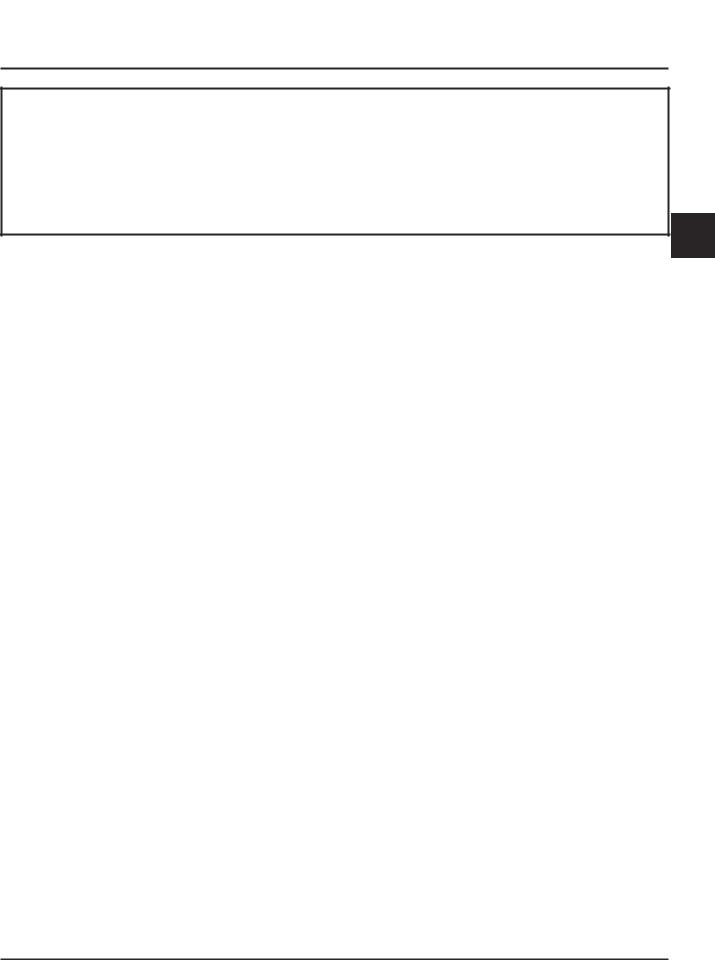
Section 3
Troubleshooting
Section 3
Troubleshooting
3
Troubleshooting Guide |
10. |
Diode in wiring harness failed in open circuit |
||
When troubles occur, be sure to check the simple |
|
mode. |
||
causes which, at first, may seem too obvious to be |
Engine Starts Hard |
|||
considered. For example, a starting problem could be |
||||
1. |
PTO drive is engaged. |
|||
caused by an empty fuel tank. |
||||
|
|
2. |
Dirt or water in the fuel system. |
|
Some general common causes of engine troubles are |
3. |
Clogged fuel line. |
||
listed below. Use these to locate the causing factors. |
4. |
Loose or faulty wires or connections. |
||
Refer to the specific section(s) within this service |
5. |
Faulty or misadjusted choke or throttle controls. |
||
manual for more detailed information. |
6. |
Faulty spark plugs. |
||
|
|
7. |
Low compression. |
|
Engine Cranks But Will Not Start |
8. |
Weak spark. |
||
1. |
Empty fuel tank. |
9. |
Fuel pump malfunction causing lack of fuel. |
|
2. |
Fuel shut-off valve closed. |
10. |
Engine overheated-cooling/air circulation |
|
3. |
Poor fuel, dirt or water in the fuel system. |
|
restricted. |
|
4. |
Clogged fuel line. |
11. |
Quality of fuel. |
|
5. |
Spark plug lead(s) disconnected. |
12. |
Flywheel key sheared. |
|
6. |
Key switch or kill switch in “off” position. |
13. |
Intake system leak. |
|
7. |
Faulty spark plugs. |
Engine Will Not Crank |
||
8. |
Faulty ignition module(s). |
|||
1. |
PTO drive is engaged. |
|||
9. |
SMART-SPARK™ malfunction (applicable models). |
|||
10. |
Carburetor solenoid malfunction. |
2. |
Battery is discharged. |
|
11. |
Diode in wiring harness failed in open circuit |
3. |
Safety interlock switch is engaged. |
|
|
mode. |
4. |
Loose or faulty wires or connections. |
|
12. |
Vacuum fuel pump malfunction, or oil in vacuum |
5. |
Faulty key switch or ignition switch. |
|
|
hose. |
6. |
Faulty electric starter or solenoid. |
|
13. |
Vacuum hose to fuel pump leaking/cracked. |
7. |
Seized internal engine components. |
|
14. |
Battery connected backwards. |
Engine Runs But Misses |
||
15. |
Safety interlock system engaged. |
|||
1. |
Dirt or water in the fuel system. |
|||
|
|
|||
Engine Starts But Does Not Keep Running |
2. |
Spark plug lead disconnected. |
||
1. |
Restricted fuel tank cap vent. |
3. |
Poor quality of fuel. |
|
2. |
Poor fuel, dirt or water in the fuel system. |
4. |
Faulty spark plug(s). |
|
3. |
Faulty or misadjusted choke or throttle controls. |
5. |
Loose wires or connections that intermittently |
|
4. |
Loose wires or connections that short the kill |
|
ground the ignition kill circuit. |
|
|
terminal of ignition module to ground. |
6. |
Engine overheated. |
|
5. |
Faulty cylinder head gasket. |
7. |
Faulty ignition module or incorrect air gap. |
|
6. |
Faulty carburetor. |
8. |
Carburetor adjusted incorrectly. |
|
7. |
Vacuum fuel pump malfunction, or oil in vacuum |
9. |
SMART-SPARK™ malfunction (applicable |
|
|
hose. |
|
models). |
|
8.Leaking/cracked vacuum hose to fuel pump.
9.Intake system leak.
3.1
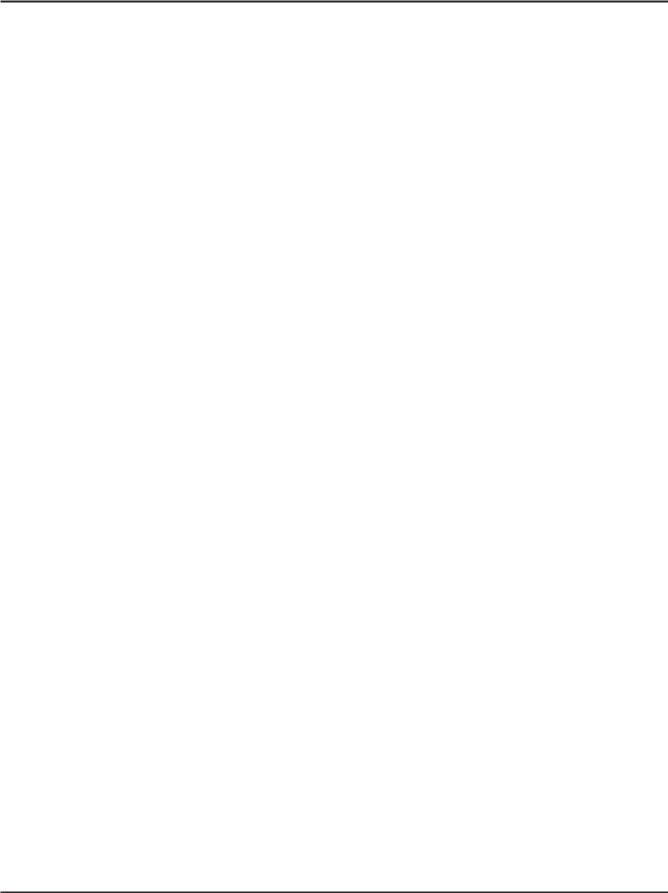
Section 3
Troubleshooting
Engine Will Not Idle
1.Dirt or water in the fuel system.
2.Stale fuel and/or gum in carburetor.
3.Faulty spark plugs.
4.Fuel supply inadequate.
5.Idle speed adjusting screw improperly set.
6.Idle fuel adjusting needle improperly set (some models).
7.Low compression.
8.Restricted fuel tank cap vent.
9.Engine overheated-cooling system/air circulation problem.
Engine Overheats
1.Air intake/grass screen, cooling fins, or cooling shrouds clogged.
2.Excessive engine load.
3.Low crankcase oil level.
4.High crankcase oil level.
5.Faulty carburetor.
6.Lean fuel mixture.
7.SMART-SPARK™ malfunction (applicable models).
Engine Knocks
1.Excessive engine load.
2.Low crankcase oil level.
3.Old or improper fuel.
4.Internal wear or damage.
5.Hydraulic lifter malfunction.
6.Quality of fuel.
7.Incorrect grade of oil.
Engine Loses Power
1.Low crankcase oil level.
2.High crankcase oil level.
3.Dirty air cleaner element.
4.Dirt or water in the fuel system.
5.Excessive engine load.
6.Engine overheated.
7.Faulty spark plugs.
8.Low compression.
9.Exhaust restriction.
10.SMART-SPARK™ malfunction (applicable models).
11.Low battery.
12.Incorrect governor setting.
Engine Uses Excessive Amount of Oil
1.Incorrect oil viscosity/type.
2.Clogged or improperly assembled breather.
3.Breather reed broken.
4.Worn or broken piston rings.
5.Worn cylinder bore.
6.Worn valve stems/valve guides.
7.Crankcase overfilled.
8.Blown head gasket/overheated.
Oil Leaks from Oil Seals, Gaskets
1.Crankcase breather is clogged or inoperative.
2.Breather reed broken.
3.Loose or improperly torqued fasteners.
4.Piston blowby or leaky valves.
5.Restricted exhaust.
External Engine Inspection
Before cleaning or disassembling the engine, make a thorough inspection of its external appearance and condition. This inspection can give clues to what might be found inside the engine (and the cause) when it is disassembled.
•Check for buildup of dirt and debris on the crankcase, cooling fins, grass screen, and other external surfaces. Dirt or debris on these areas are causes of higher operating temperatures and overheating.
•Check for obvious fuel and oil leaks, and damaged components. Excessive oil leakage can indicate a clogged or improperly-assembled breather, worn/damaged seals and gaskets, or loose or improperly-torqued fasteners.
•Check the air cleaner cover and base for damage or indications of improper fit and seal.
•Check the air cleaner element. Look for holes, tears, cracked or damaged sealing surfaces, or other damage that could allow unfiltered air into the engine. Also note if the element is dirty or clogged. These could indicate that the engine has been under serviced.
•Check the carburetor throat for dirt. Dirt in the throat is further indication that the air cleaner is not functioning properly.
•Check the oil level. Note if the oil level is within the operating range on the dipstick, or if it is low or overfilled.
3.2
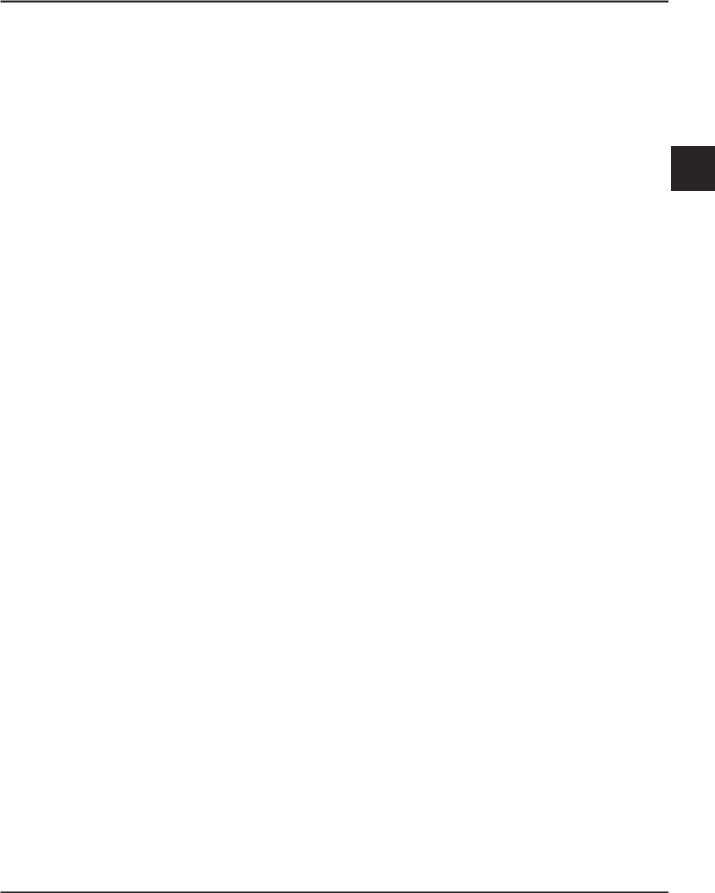
Section 3
Troubleshooting
•Check the condition of the oil. Drain the oil into a container - the oil should flow freely. Check for metal chips and other foreign particles.
Sludge is a natural by-product of combustion; a small accumulation is normal. Excessive sludge formation could indicate overrich carburetion, weak ignition, overextended oil change interval or wrong weight or type of oil was used, to name a few.
NOTE: It is good practice to drain oil at a location away from the workbench. Be sure to allow ample time for complete drainage.
To test the crankcase vacuum with the manometer:
1.Insert the stopper/hose into the oil fill hole. Leave the other tube of manometer open to atmosphere. Make sure the shut off clamp is closed.
2.Start the engine and run at no-load high speed (3200 to 3750 RPM).
3
3.Open the clamp and note the water level in the tube.
The level in the engine side should be a minimum of 10.2 cm (4 in.) above the level in the open side.
Cleaning the Engine
After inspecting the external condition of the engine, clean the engine thoroughly before disassembling it. Also clean individual components as the engine is disassembled. Only clean parts can be accurately inspected and gauged for wear or damage. There are many commercially available cleaners that will quickly remove grease, oil, and grime from engine parts. When such a cleaner is used, follow the manufacturer’sinstructionsandsafetyprecautionscarefully.
Make sure all traces of the cleaner are removed before the engine is reassembled and placed into operation. Even small amounts of these cleaners can quickly break down the lubricating properties of engine oil.
Basic Engine Tests
Crankcase Vacuum Test
A partial vacuum should be present in the crankcase when the engine is operating. Pressure in the crankcase (normally caused by a clogged or improperly assembled breather) can cause oil to be forced out at oil seals, gaskets, or other available spots.
Crankcase vacuum is best measured with either a water manometer or a vacuum gauge (see Section 2). Complete instructions are provided in the kits.
If the level in the engine side is less than specified (low/no vacuum), or the level in the engine side is lower than the level in the open side (pressure), check for the conditions in the table on page 3.4.
4.Close the shut off clamp before stopping the engine.
To test the crankcase vacuum with the Vacuum/ Pressure Gauge Kit (see Section 2):
1.Remove the dipstick or oil fill plug/cap.
2.Install the adapter into the oil fill/dipstick tube opening, upside down over the end of a small diameter dipstick tube, or directly into engine if a tube is not used.
3.Push the barbed fitting on the gauge solidly into the hole in the adapter.
4.Start the engine and bring it up to operating speed (3200-3600 RPM).
5.Check the reading on the gauge. If the reading is to the left of “0” on the gauge, vacuum or negative pressure is indicated. If the reading is to the right of “0” on the gauge, positive pressure is present.
Crankcase vacuum should be 4-10 (inches of water) If the reading is below specification, or if pressure is present, check the following table for possible causes and remedies.
3.3
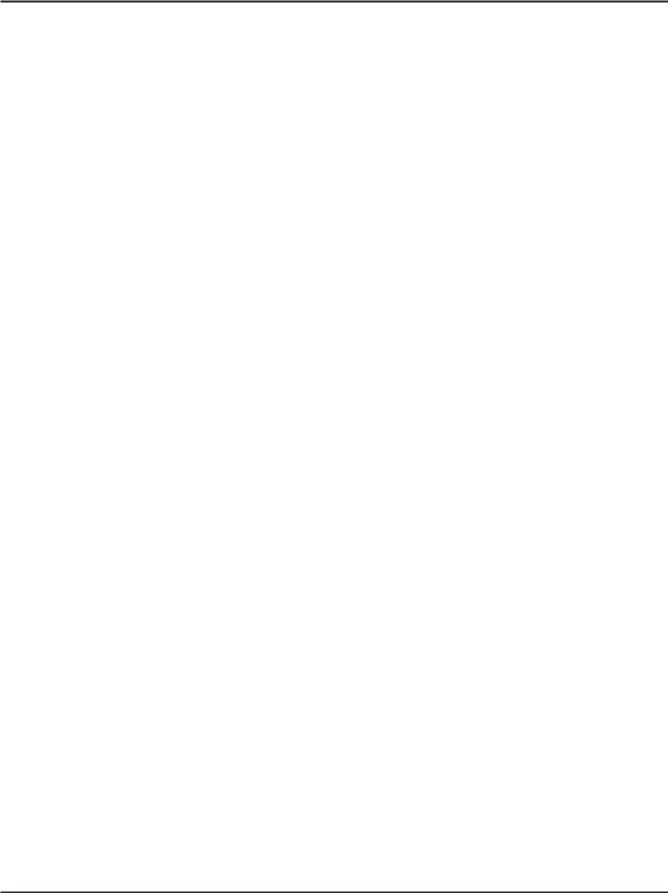
Section 3
Troubleshooting
No Crankcase Vacuum/Pressure in Crankcase
|
Possible Cause |
|
Solution |
|
|
|
|
1. |
Crankcase breather clogged or inoperative. |
1. |
Disassemble breather, clean parts thoroughly, |
|
|
|
check sealing surfaces for flatness, reassemble, |
|
|
|
and recheck pressure. |
2. |
Seals and/or gaskets leaking. Loose or |
2. |
Replace all worn or damaged seals and gaskets. |
|
improperly torqued fasteners. |
|
Make sure all fasteners are tightened securely. |
|
|
|
Use appropriate torque values and sequences |
|
|
|
when necessary. |
3. |
Piston blowby or leaky valves (confirm by |
3. |
Recondition piston, rings, cylinder bore, valves, |
|
inspecting components). |
|
and valve guides. |
4. |
Restricted exhaust. |
4. |
Repair/replace restricted muffler/exhaust |
|
|
|
system. |
|
|
|
|
Compression Test
Some of these engines are equipped with an automatic compression release (ACR) mechanism. Because of the ACR mechanism, it is difficult to obtain an accurate compression reading. As an alternative, perform a cylinder leakdown test.
Cylinder Leakdown Test
A cylinder leakdown test can be a valuable alternative to a compression test. By pressurizing the combustion chamber from an external air source you can determine if the valves or rings are leaking, and how badly.
Cylinder Leakdown Tester (see Section 2) is a relatively simple, inexpensive leakdown tester for small engines. The tester includes a quick disconnect for attaching the adapter hose, and a holding tool.
Leakdown Test Instructions
1.Run engine for 3-5 minutes to warm it up.
2.Remove spark plug(s) and air filter from engine.
3.Rotate the crankshaft until the piston (of cylinder being tested) is at top dead center of the compression stroke. Hold the engine in this position while testing. The holding tool supplied with the tester can be used if the PTO end of the crankshaft is accessible. Lock the holding tool onto the crankshaft. Install a 3/8" breaker bar into the hole/slot of the holding tool, so it is perpendicular to both the holding tool and crankshaft PTO.
If the flywheel end is more accessible, use a breaker bar and socket on the flywheel nut/ screw to hold it in position. An assistant may be needed to hold the breaker bar during testing. If the engine is mounted in a piece of equipment, it may be possible to hold it by clamping or wedging a driven component. Just be certain that the engine cannot rotate off of TDC in either direction.
4.Install the adapter into the spark plug hole, but do not attach it to the tester at this time.
5.Connect an air source of at least 50 psi to the tester.
6.Turn the regulator knob in the increase (clockwise) direction until the gauge needle is in the yellow “set” area at the low end of the scale.
7.Connect the tester quick-disconnect to the adapter hose while firmly holding the engine at TDC. Note the gauge reading and listen for escaping air at the carburetor intake, exhaust outlet, and crankcase breather.
8.Check your test results against the following table:
3.4
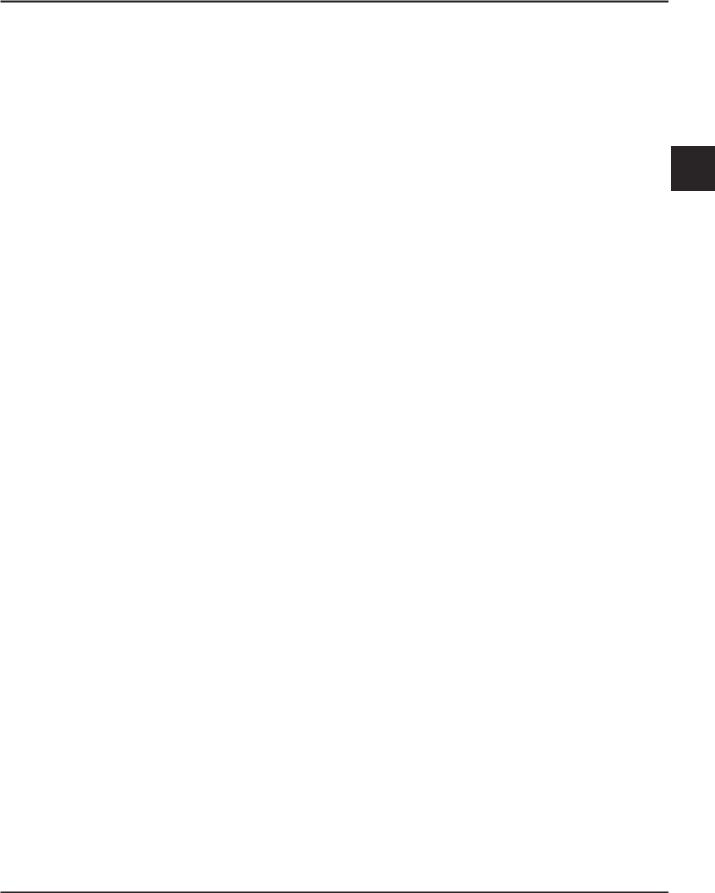
|
Section 3 |
|
|
Troubleshooting |
|
Leakdown Test Results |
|
|
Air escaping from crankcase breather ........................................................ |
Defective rings or worn cylinder. |
|
Air escaping from exhaust system .............................................................. |
Defective exhaust valve/improper seating. |
|
Air escaping from carburetor ....................................................................... |
Defective intake valve/improper seating. |
|
Gauge reading in “low” (green) zone .......................................................... |
Piston rings and cylinder in good |
|
|
condition. |
|
Gauge reading in “moderate” (yellow) zone .............................................. |
Engine is still usable, but there is some |
|
|
wear present. Customer should start |
|
|
planning for overhaul or replacement. |
|
Gauge reading in “high” (red) zone ............................................................. |
Rings and/or cylinder have considerable |
3 |
|
wear. Engine should be reconditioned or |
|
|
replaced. |
|
3.5
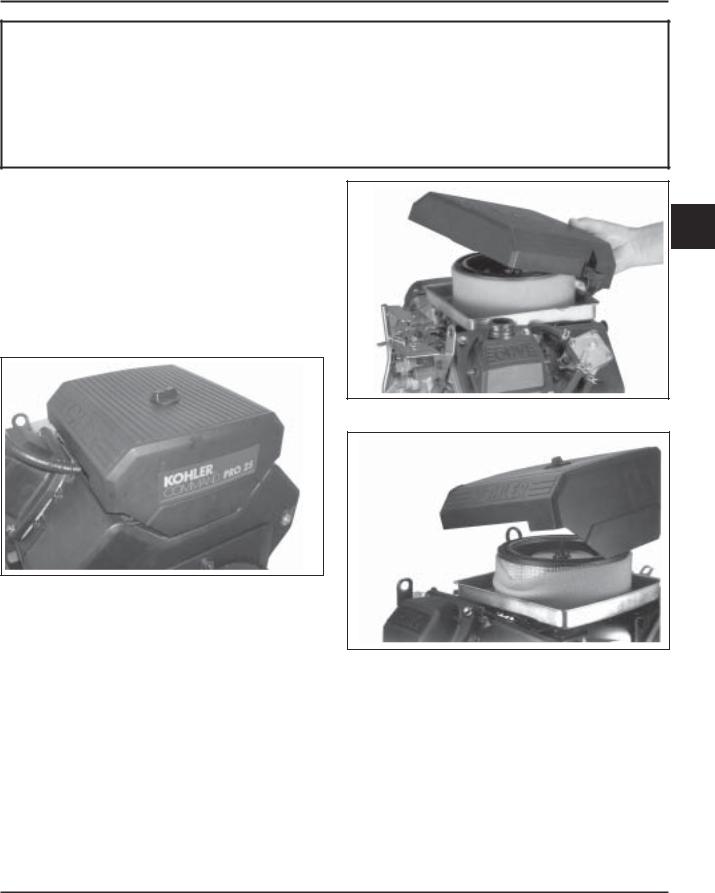
Section 4
Air Cleaner and Air Intake System
Air Cleaners
General
Most engines are equipped with a replaceable, highdensity paper air cleaner element, surrounded by an oiled foam precleaner, and housed under a flat outer cover. This is typically referred to as the standard air cleaner assembly. See Figures 4-1 and 4-4. Some engines utilize a heavy-duty style air cleaner as shown in Figure 4-12.
Figure 4-1. Standard Air Cleaner.
Standard Air Cleaner
Service
Check the air cleaner daily or before starting the engine. Check for and correct any buildup of dirt and debris, along with loose or damaged components.
NOTE: Operating the engine with loose or damaged air cleaner components could allow unfiltered air into the engine, causing premature wear and failure.
4
Figure 4-2. Removing Latch Style Cover.
Cover
Air Cleaner Element 
Precleaner
Figure 4-3. Removing Knob Style Cover.
Precleaner Service
If so equipped, wash and reoil the precleaner every 25 hours of operation (more often under extremely dusty or dirty conditions).
To service the precleaner, perform the following steps:
1.Unhook the latches or loosen the retaining knob, and remove the cover.
2.Remove the foam precleaner from the paper air cleaner element.
4.1
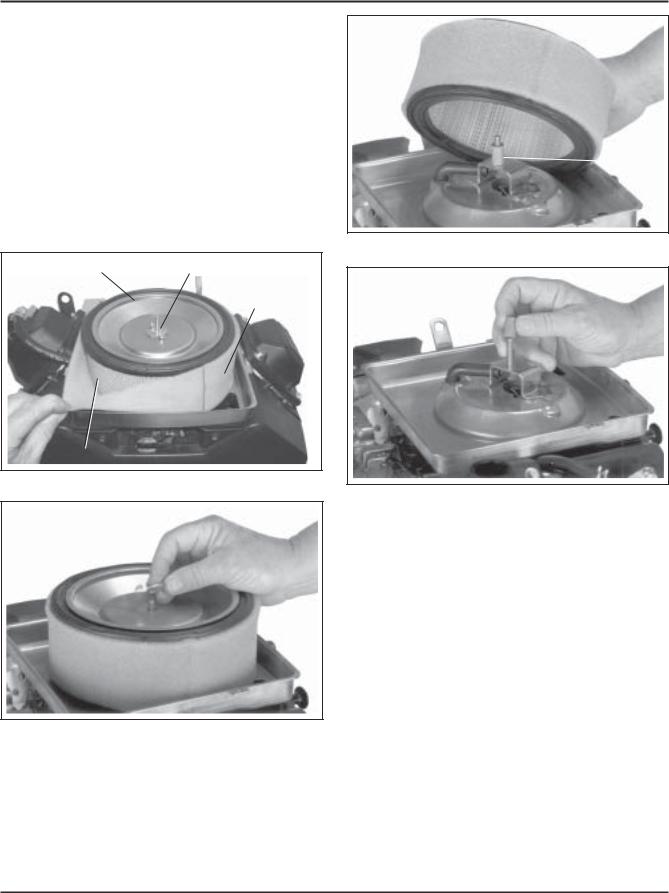
Section 4
Air Cleaner and Air Intake System
3.Wash the precleaner in warm water with detergent. Rinse the precleaner thoroughly until all traces of detergent are eliminated. Squeeze out excess water (do not wring). Allow the precleaner to air dry.
4.Saturate the precleaner with new engine oil. Squeeze out all excess oil.
5.Reinstall the precleaner over the paper air cleaner element.
6.Reinstall the air cleaner cover. Secure the cover with the two latches or the retaining knob.
Element Cover |
Wing Nut |
Precleaner
Element
Figure 4-4. Air Cleaner Components.
Figure 4-5. Removing Element Cover Wing Nut.
 Seal
Seal
Figure 4-6. Removing Elements.
Figure 4-7. Removing Rubber Seal from Bracket.
Paper Element Service (Standard Type)
Every 100 hours of operation (more often under extremely dusty or dirty conditions), replace the paper element. Follow these steps:
1.Unhook the latches or loosen the retaining knob, and remove the cover.
2.Remove the wing nut, element cover, and paper element with precleaner (if so equipped).
3.Remove the precleaner (if so equipped) from the paper element. Service the precleaner as described in "Precleaner Service".
4.Do not wash the paper element or use pressurized air, as this will damage the element. Replace a dirty, bent, or damaged element with a genuine Kohler element. Handle new elements carefully; do not use if the sealing surfaces are bent or damaged.
4.2
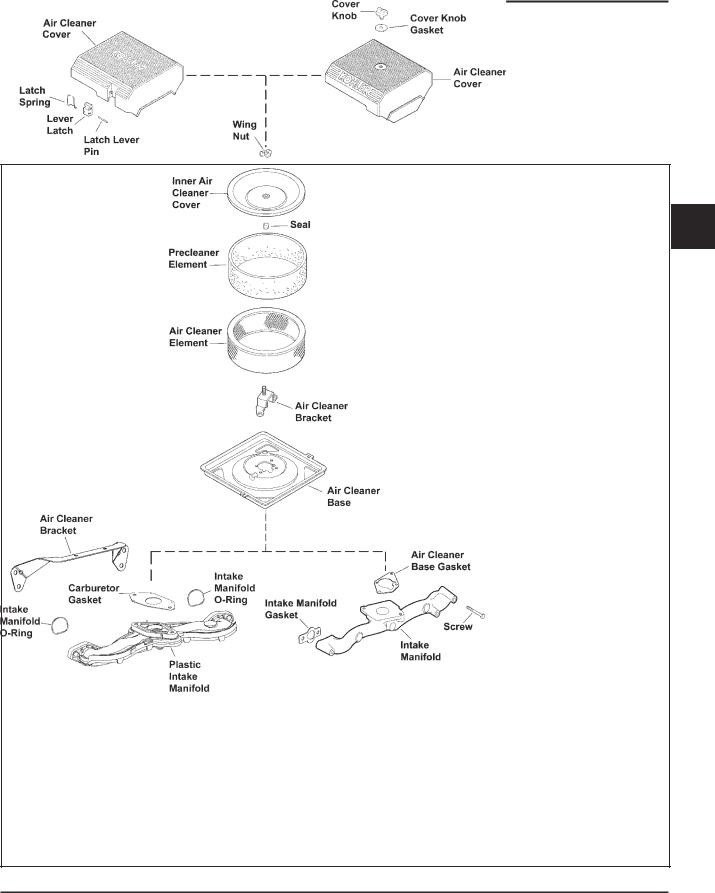
Section 4
Air Cleaner and Air Intake System
5.Check the seal for any damage or deterioration. Replace as necessary. See Figure 4-7.
6.Reinstall the seal, paper element, precleaner, element cover, and wing nut.
7.Reinstall the air cleaner cover and secure with the latches or the retaining knob.
NOTE: Make sure the correct depth air cleaner element and rubber seal are used for the engine spec involved. Some engines use a deeper or extra capacity air cleaner and a longer rubber seal.
4
Figure 4-8. Exploded View of Standard Air Intake System Components.
4.3
